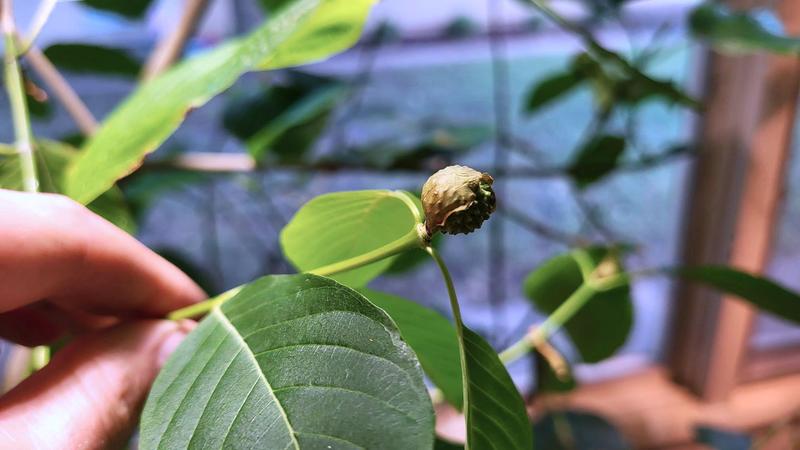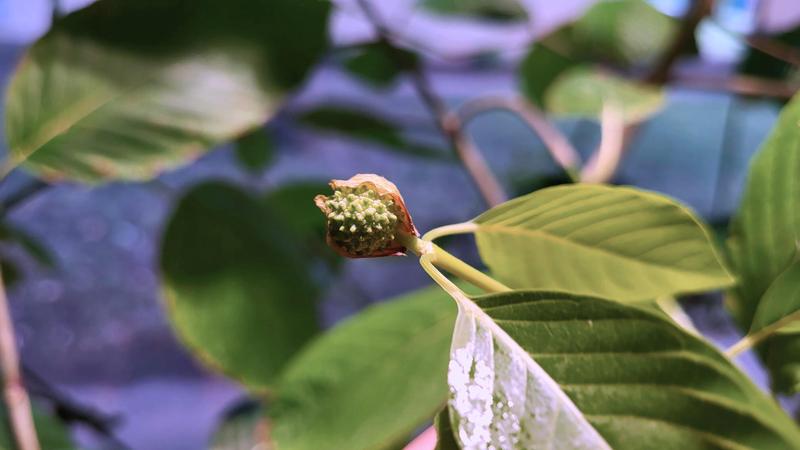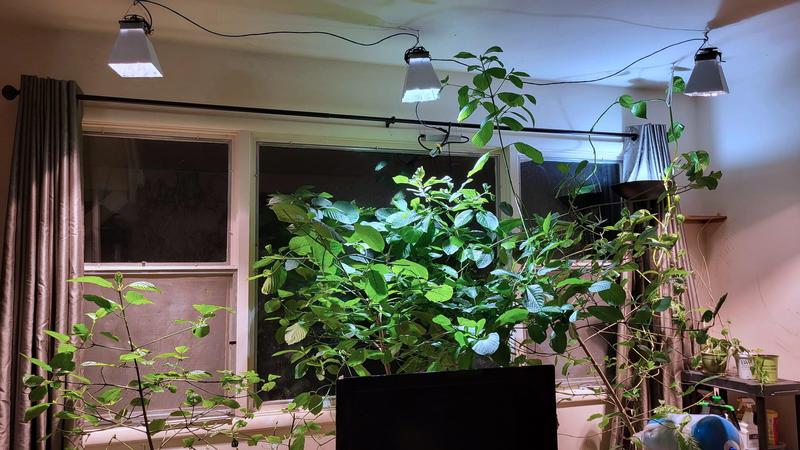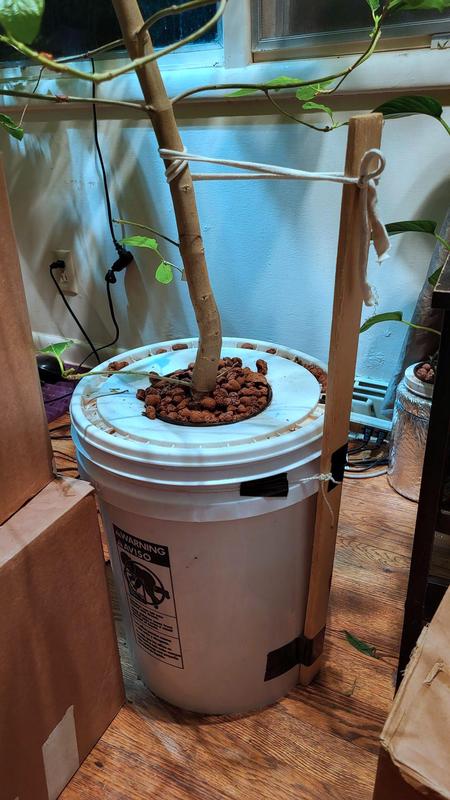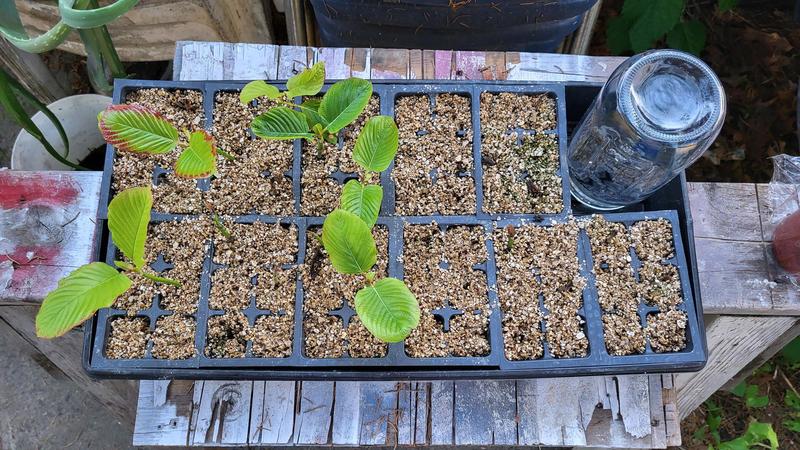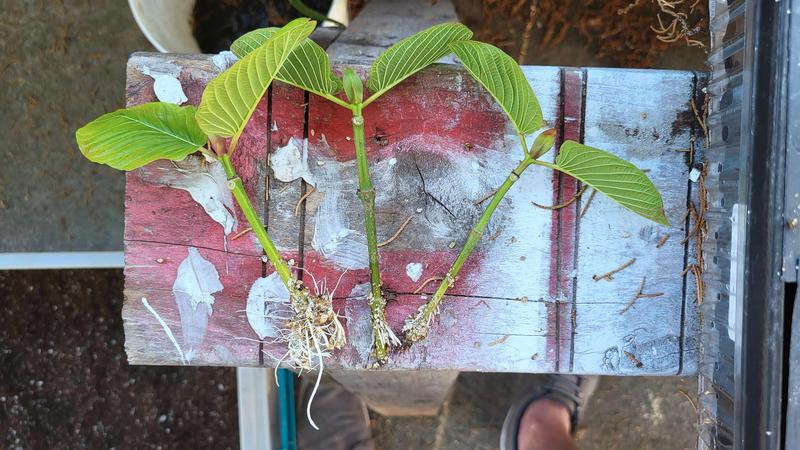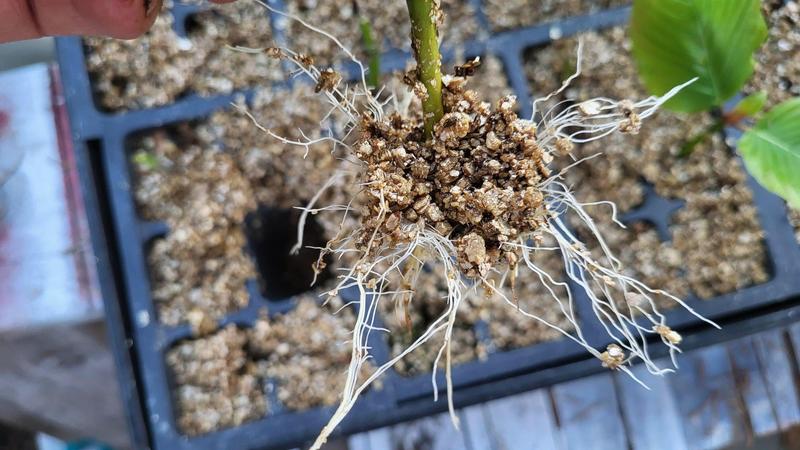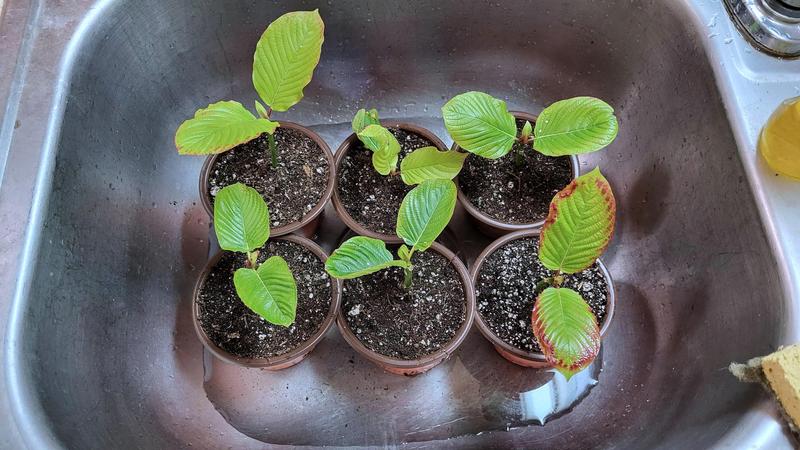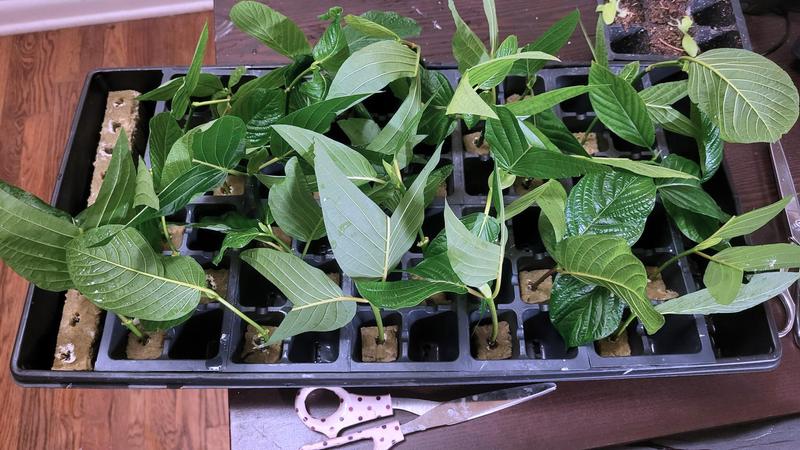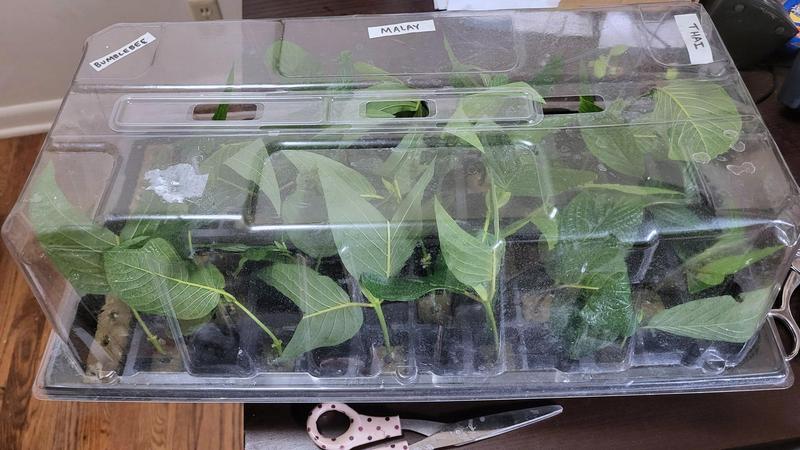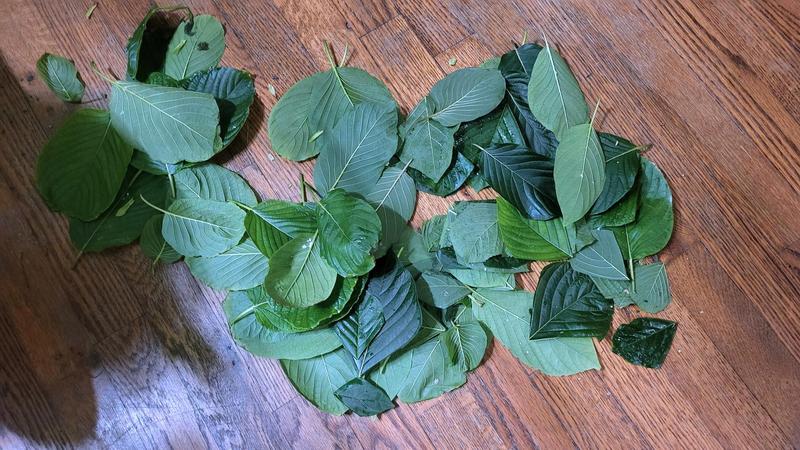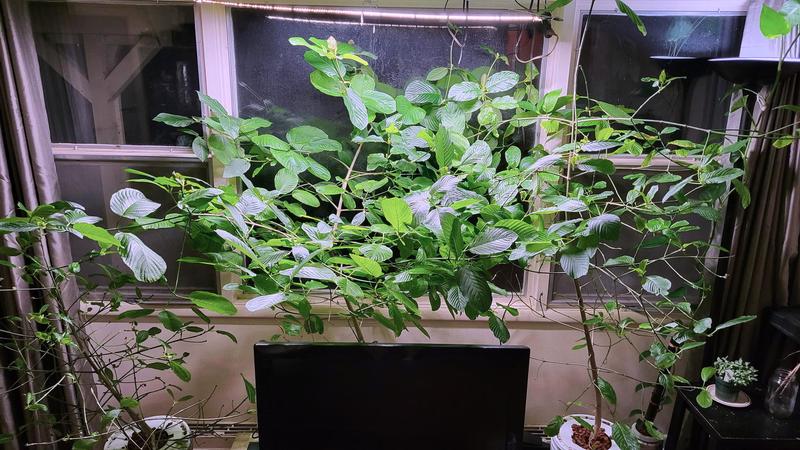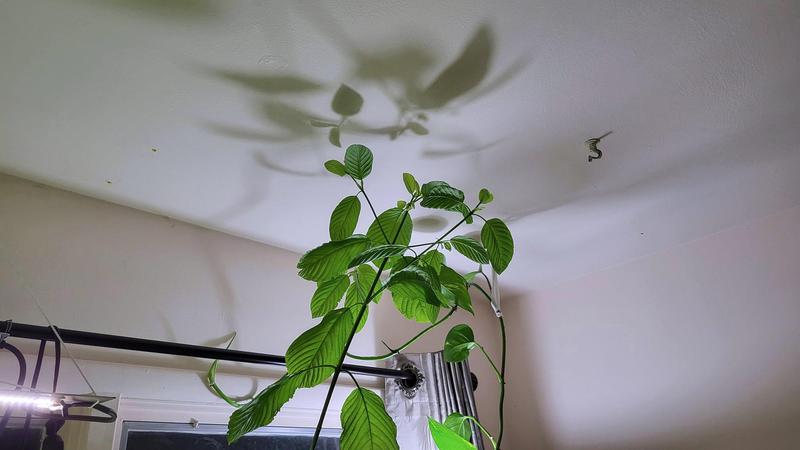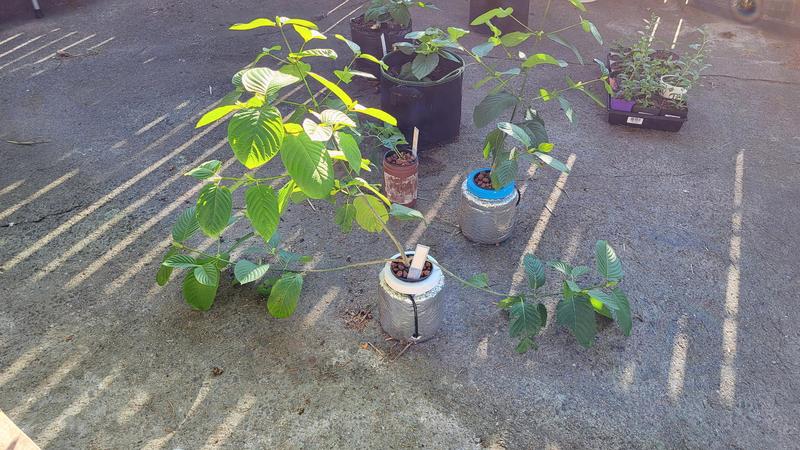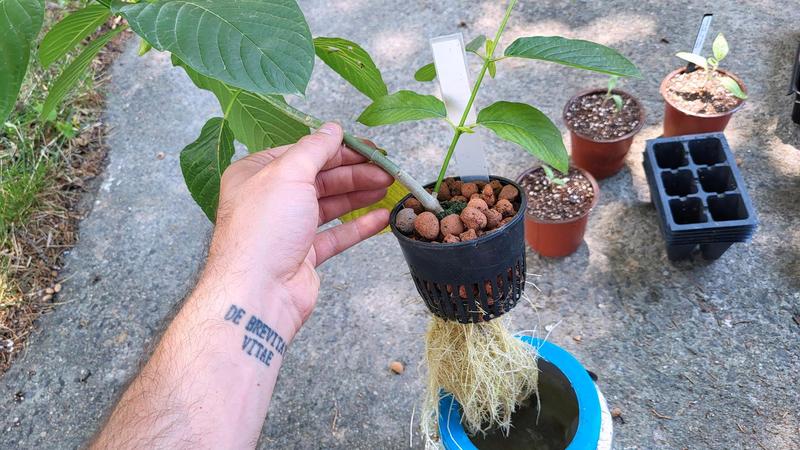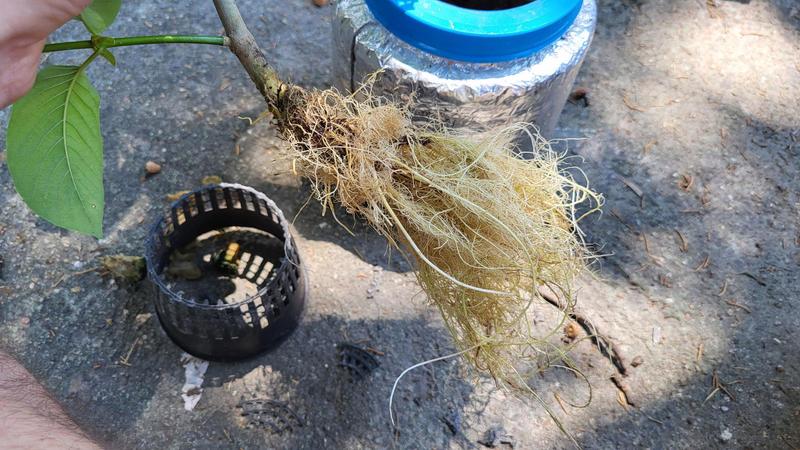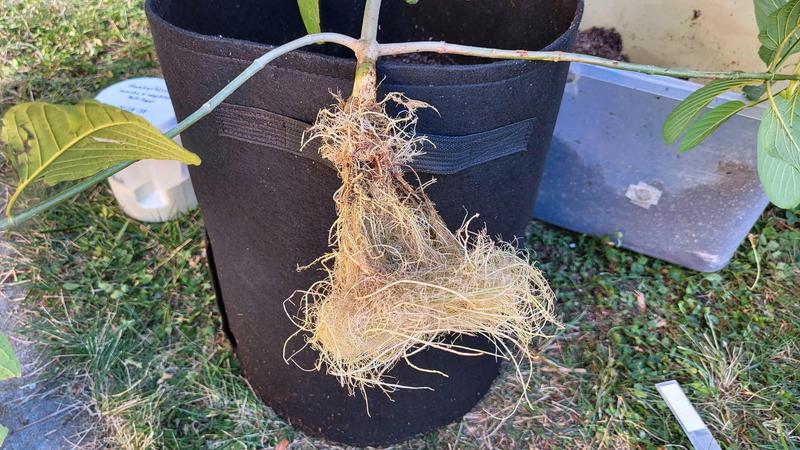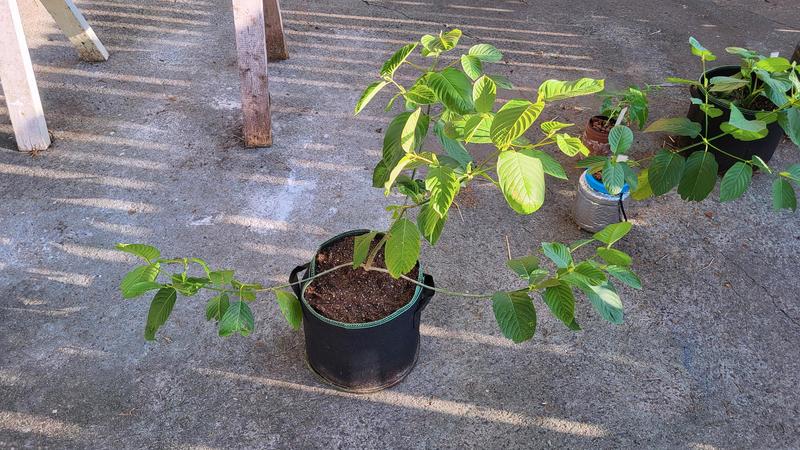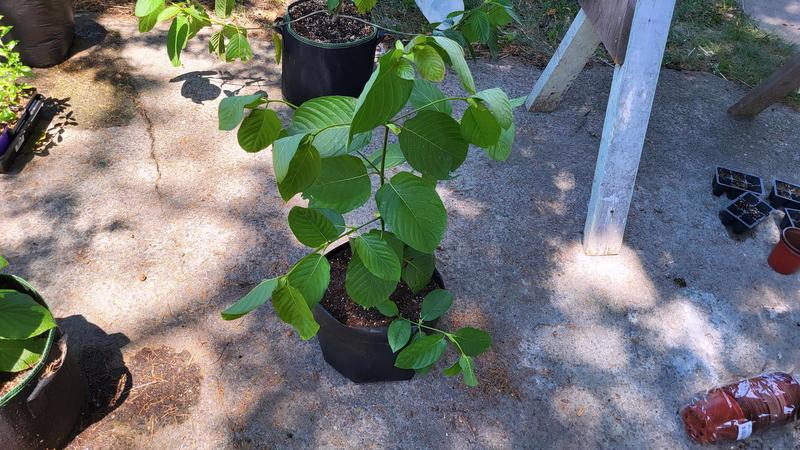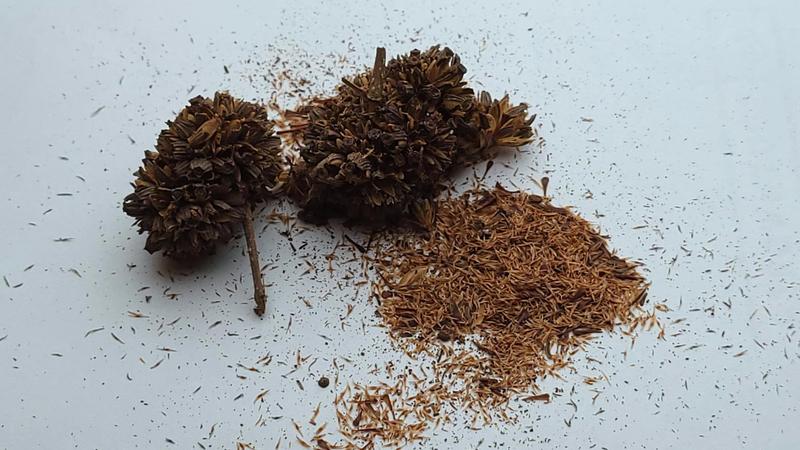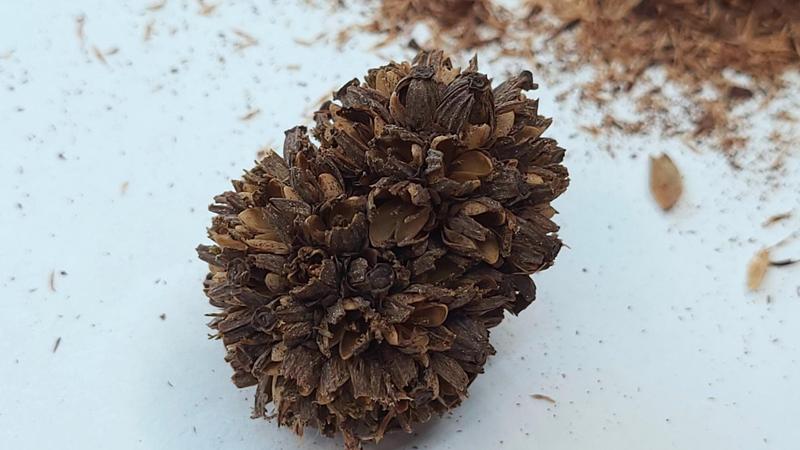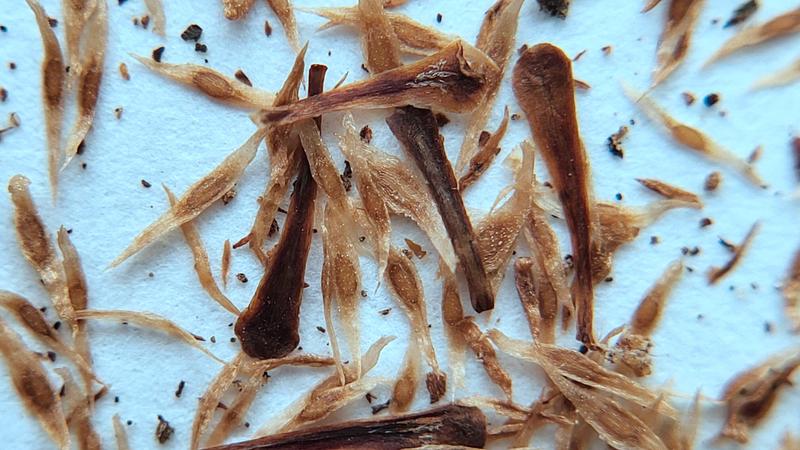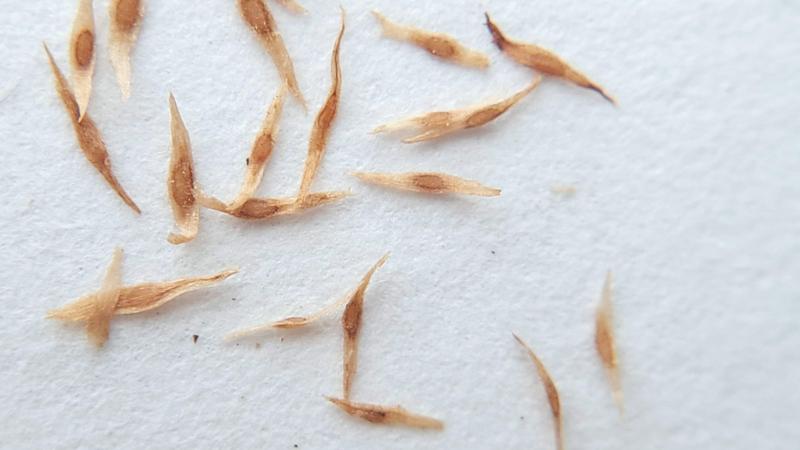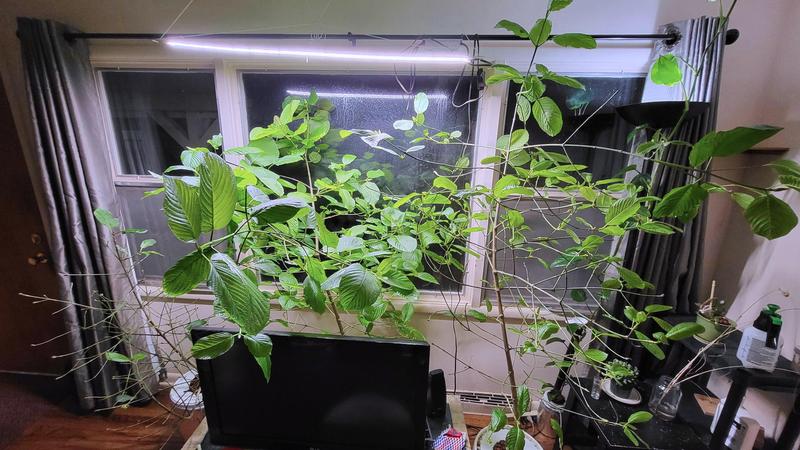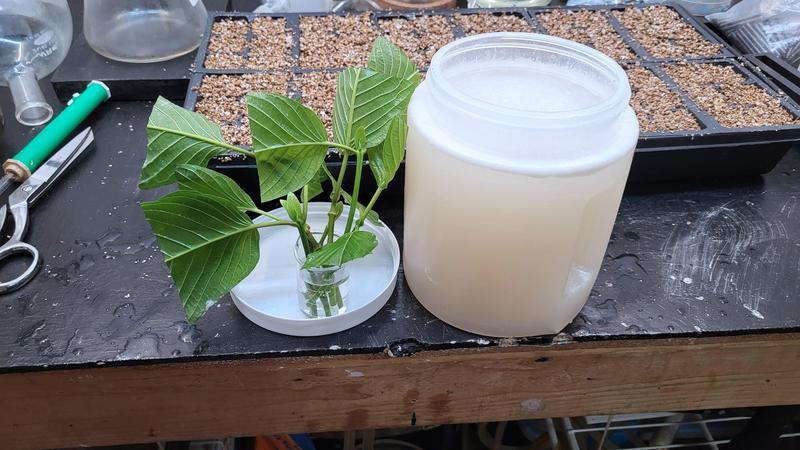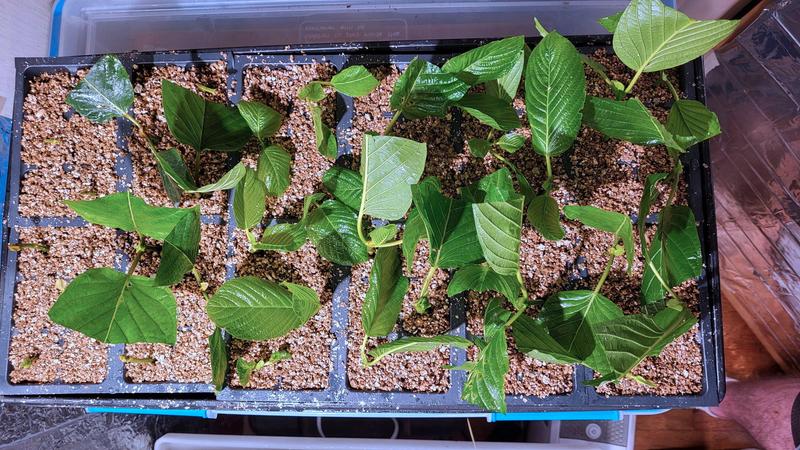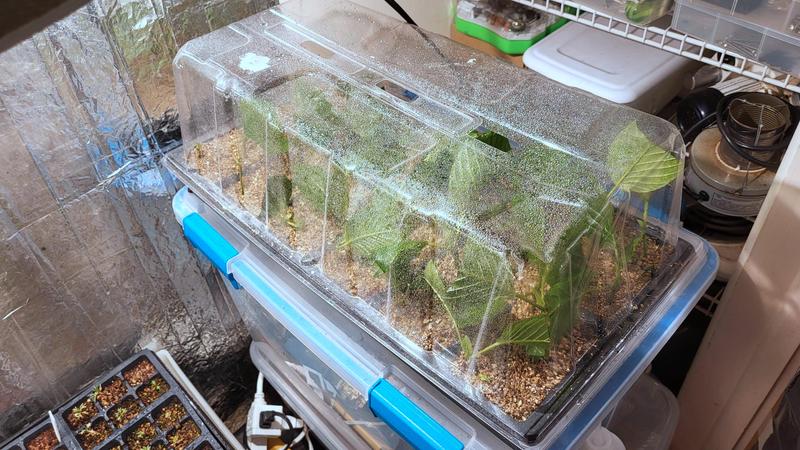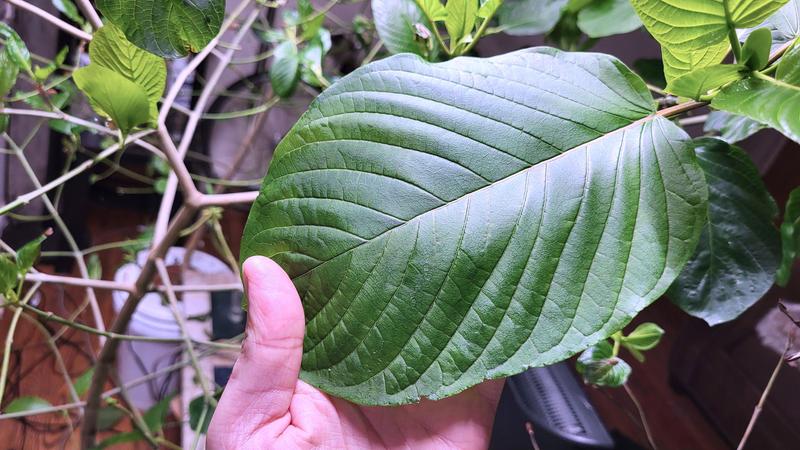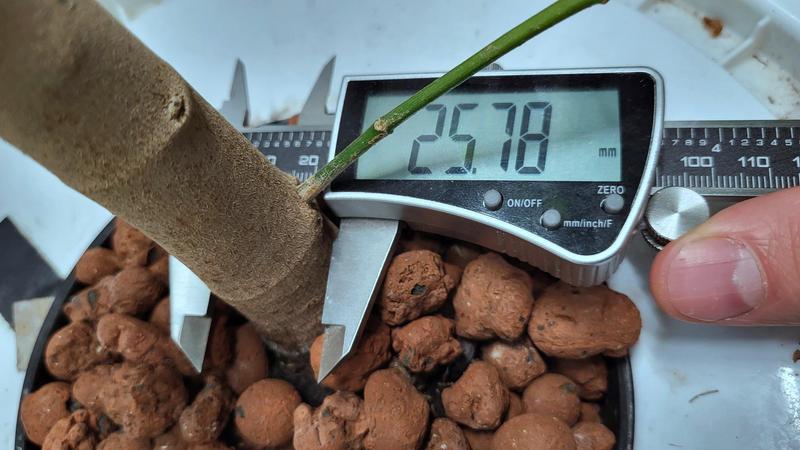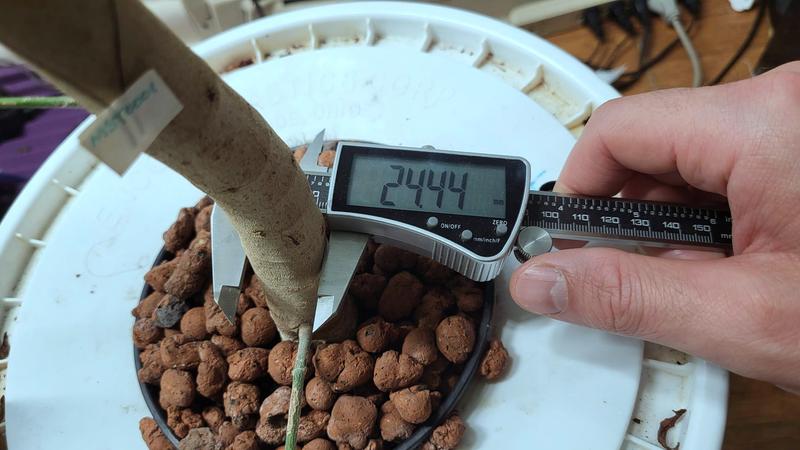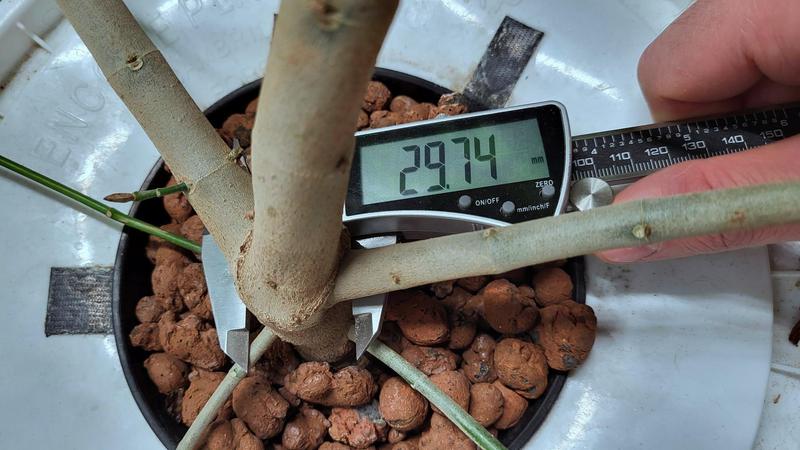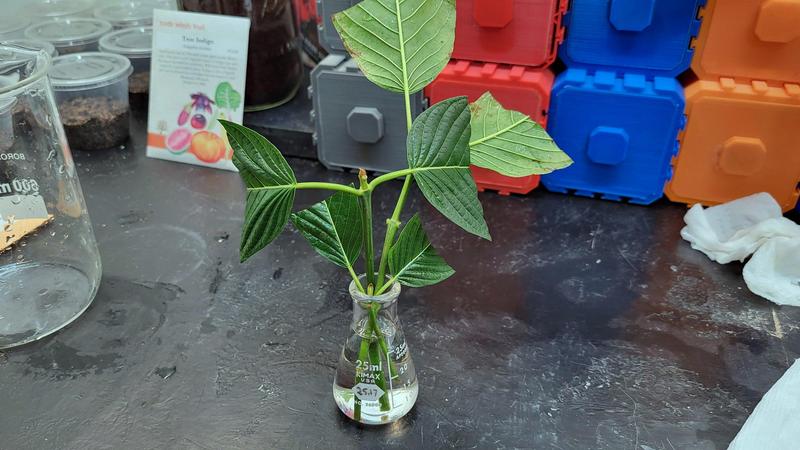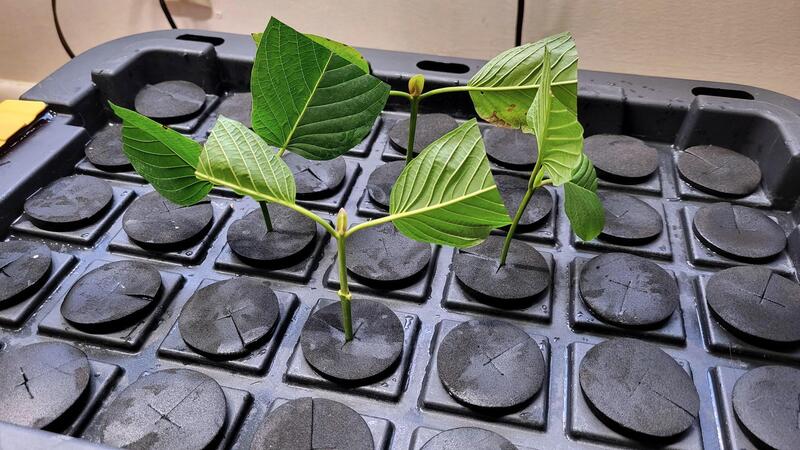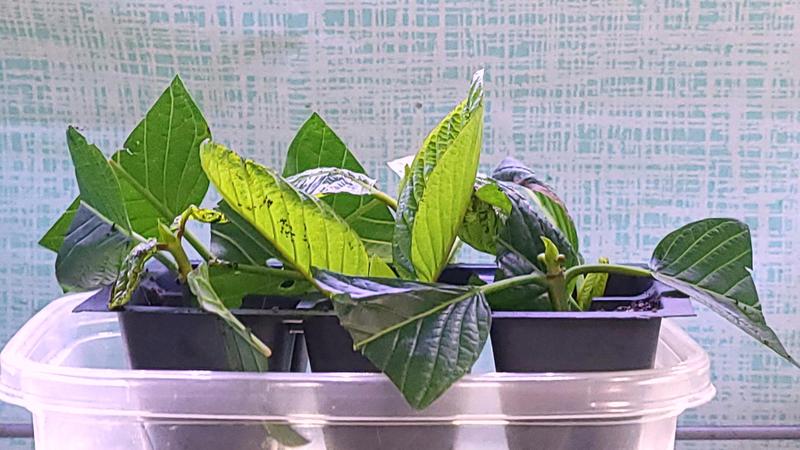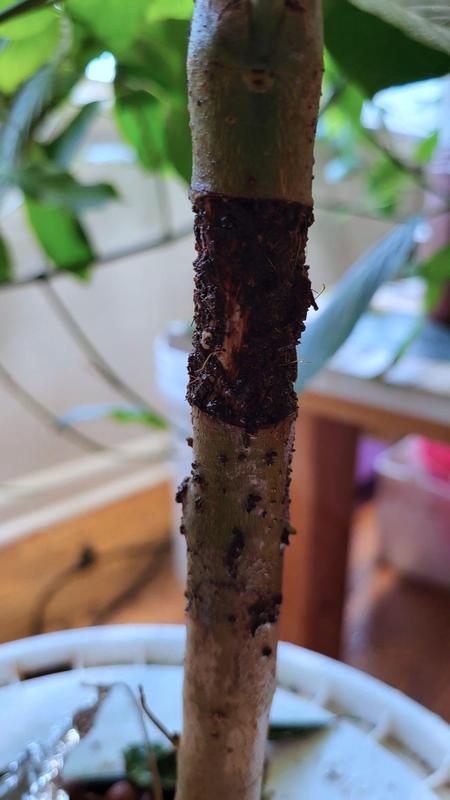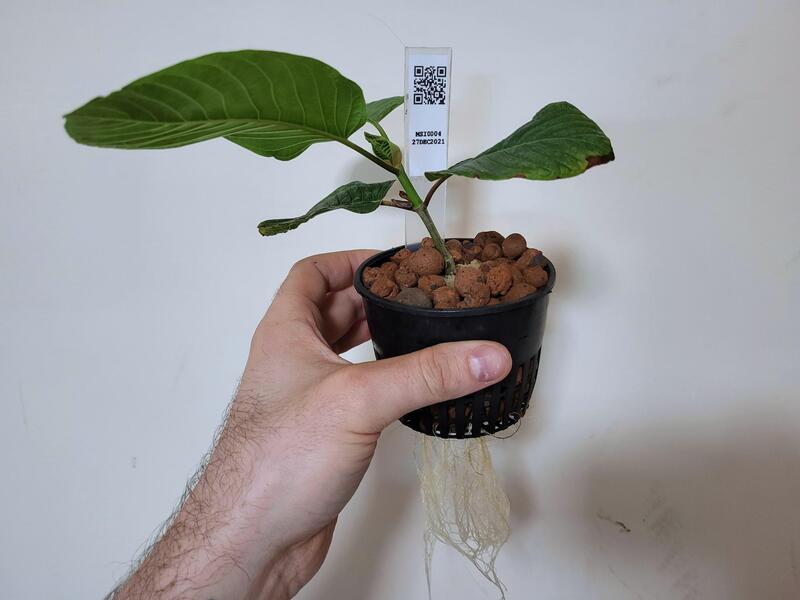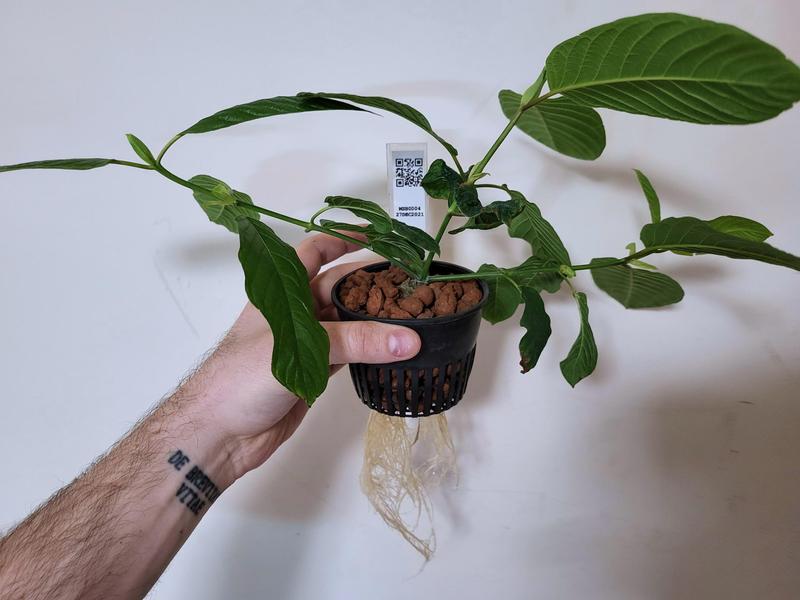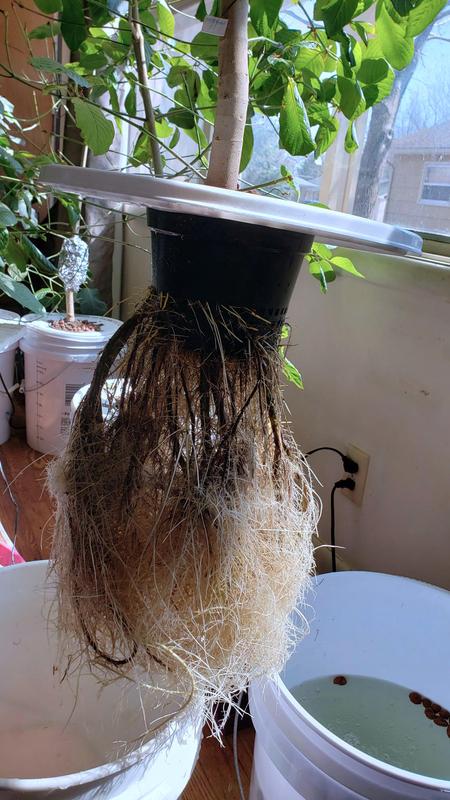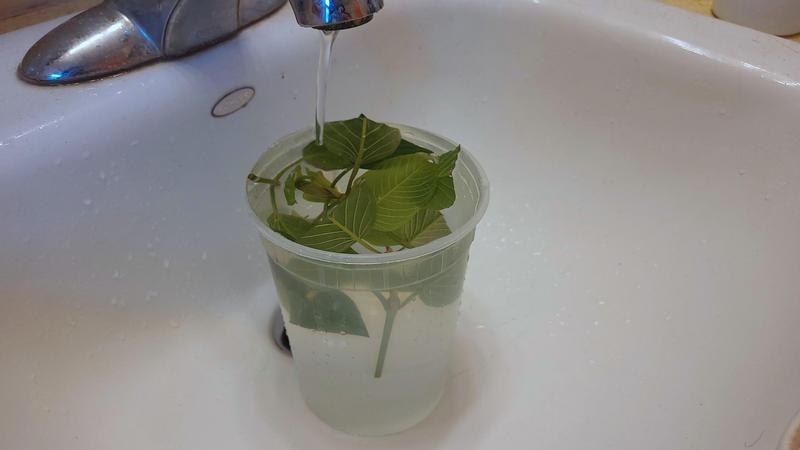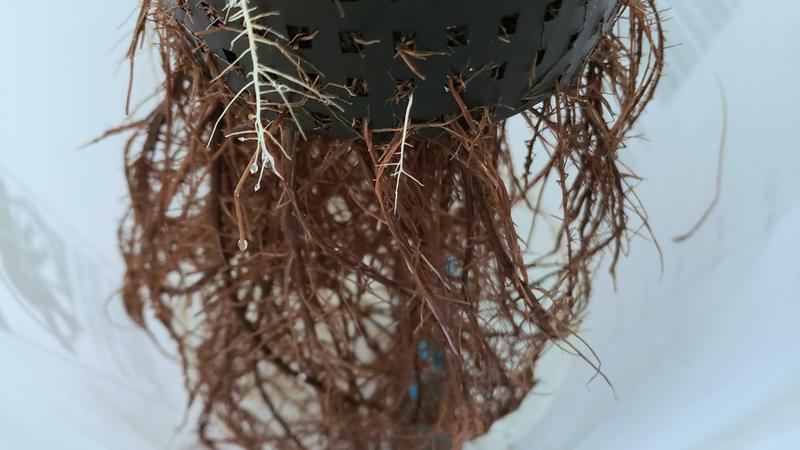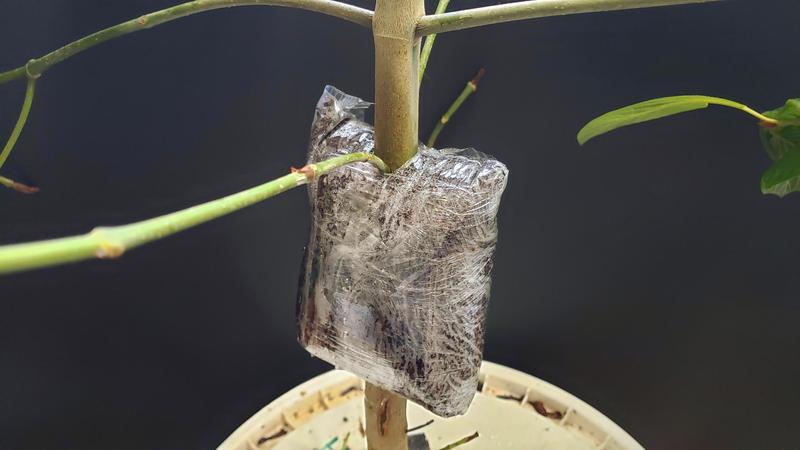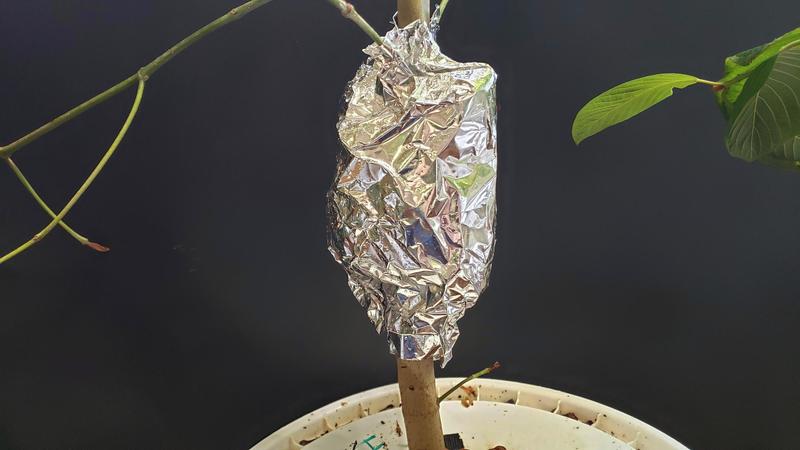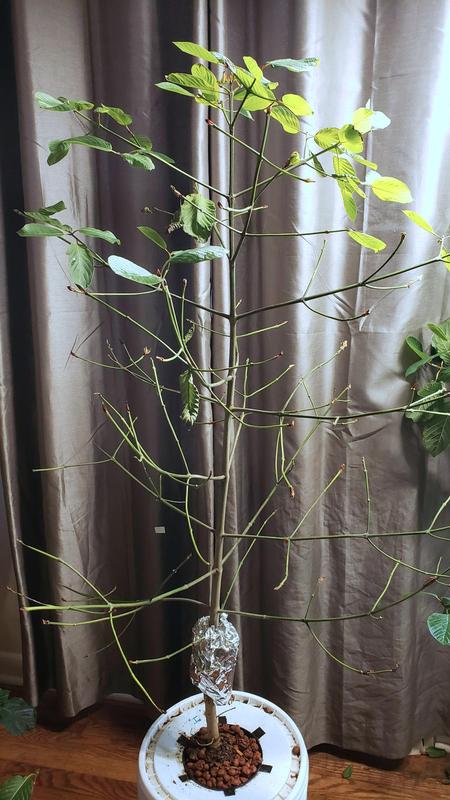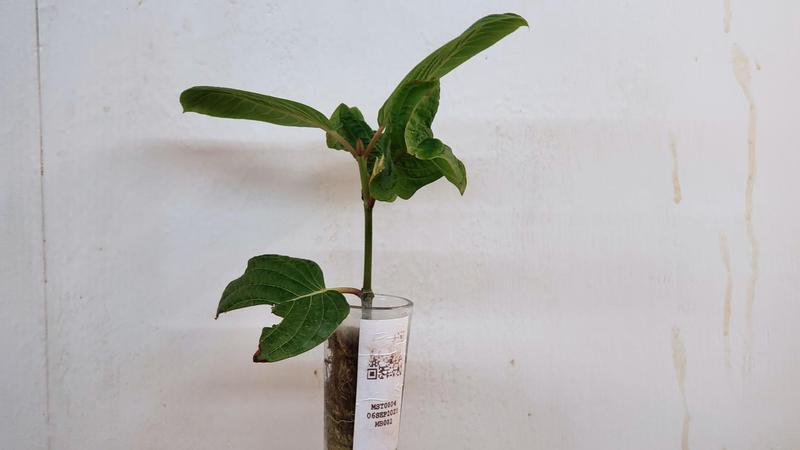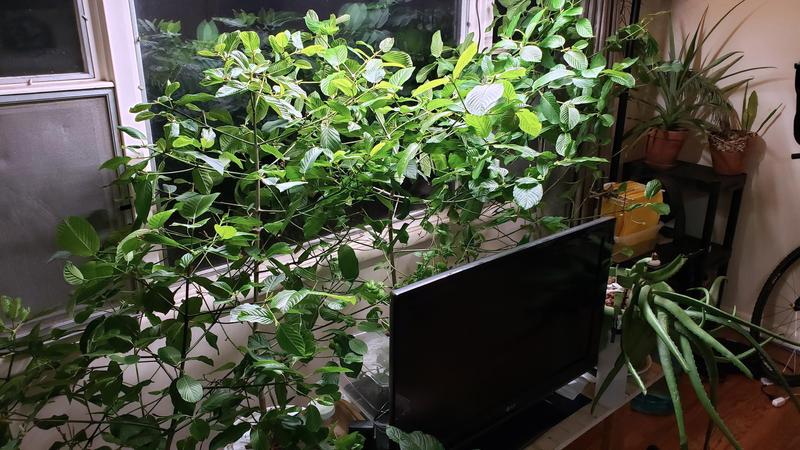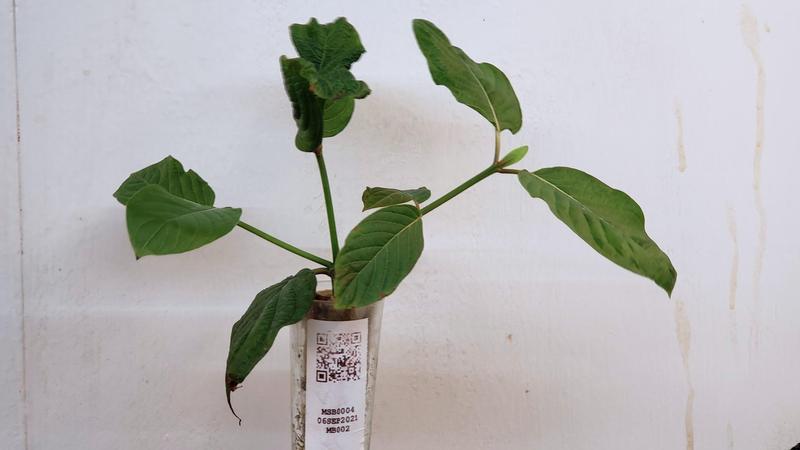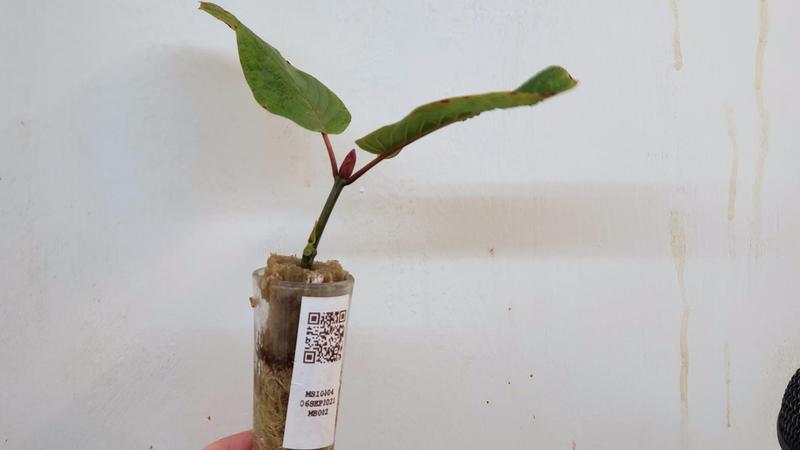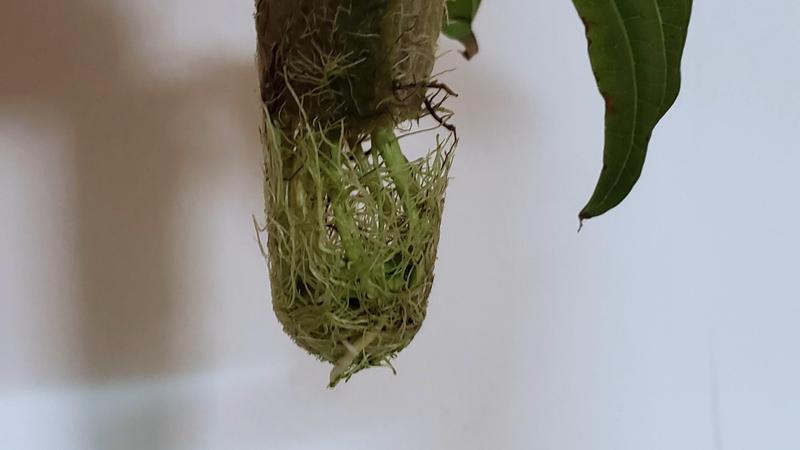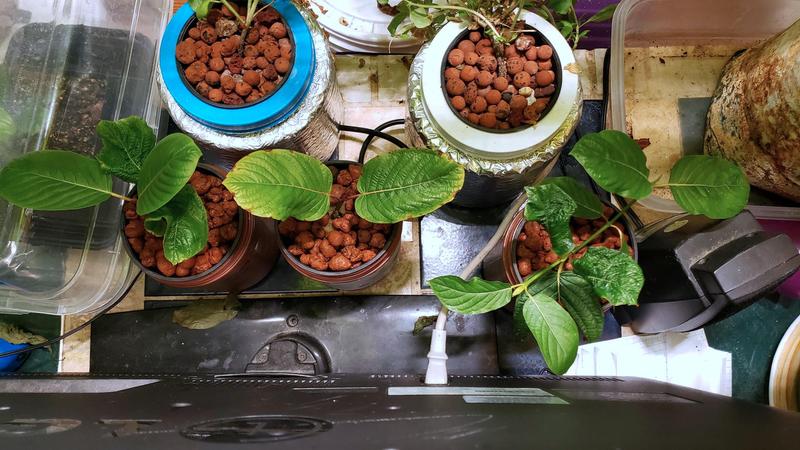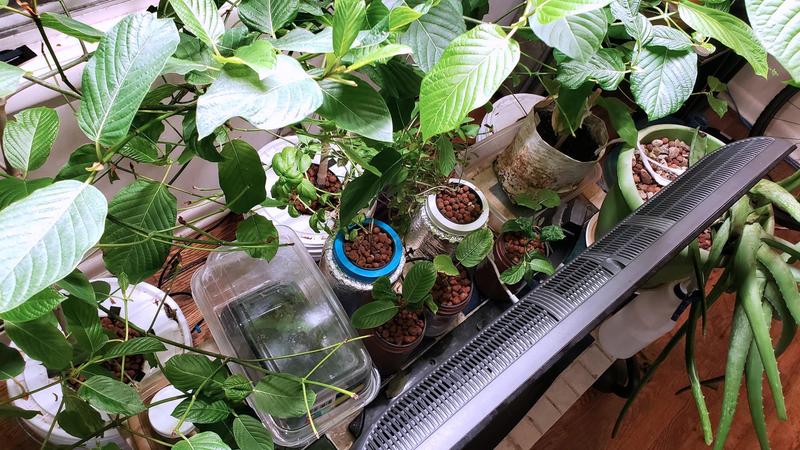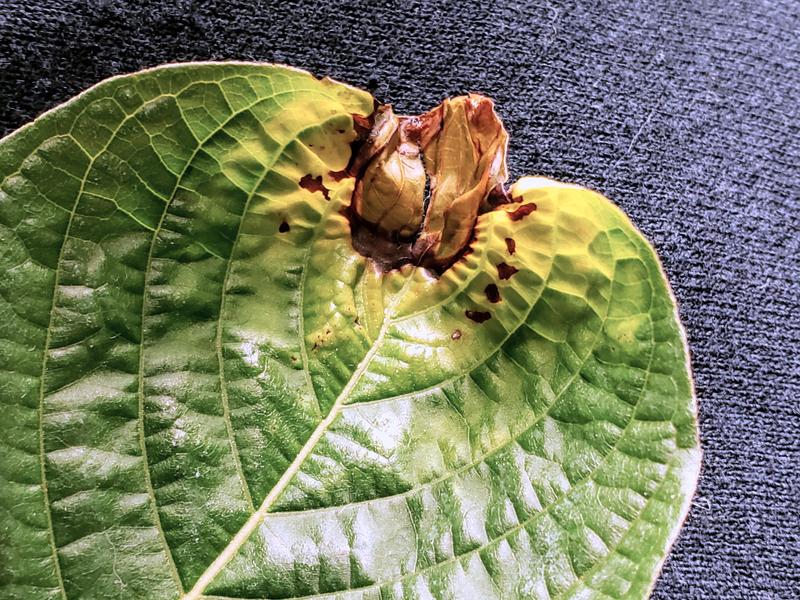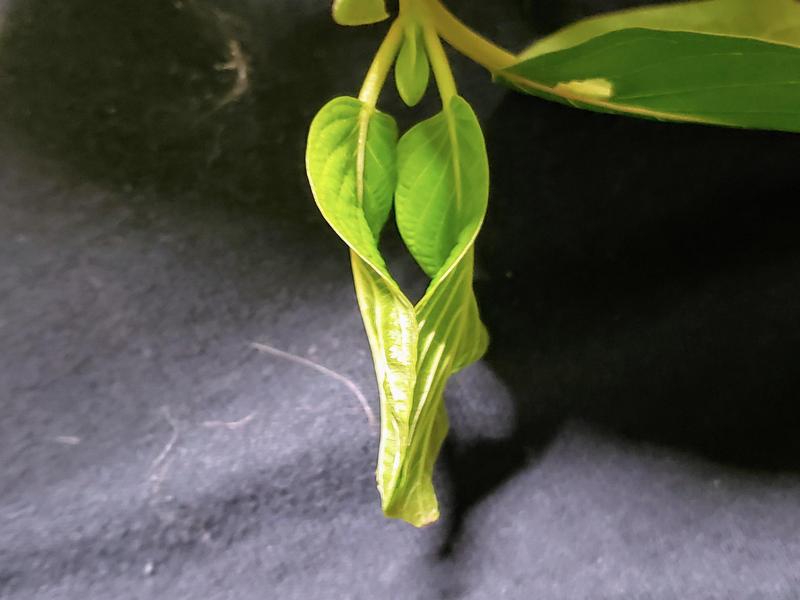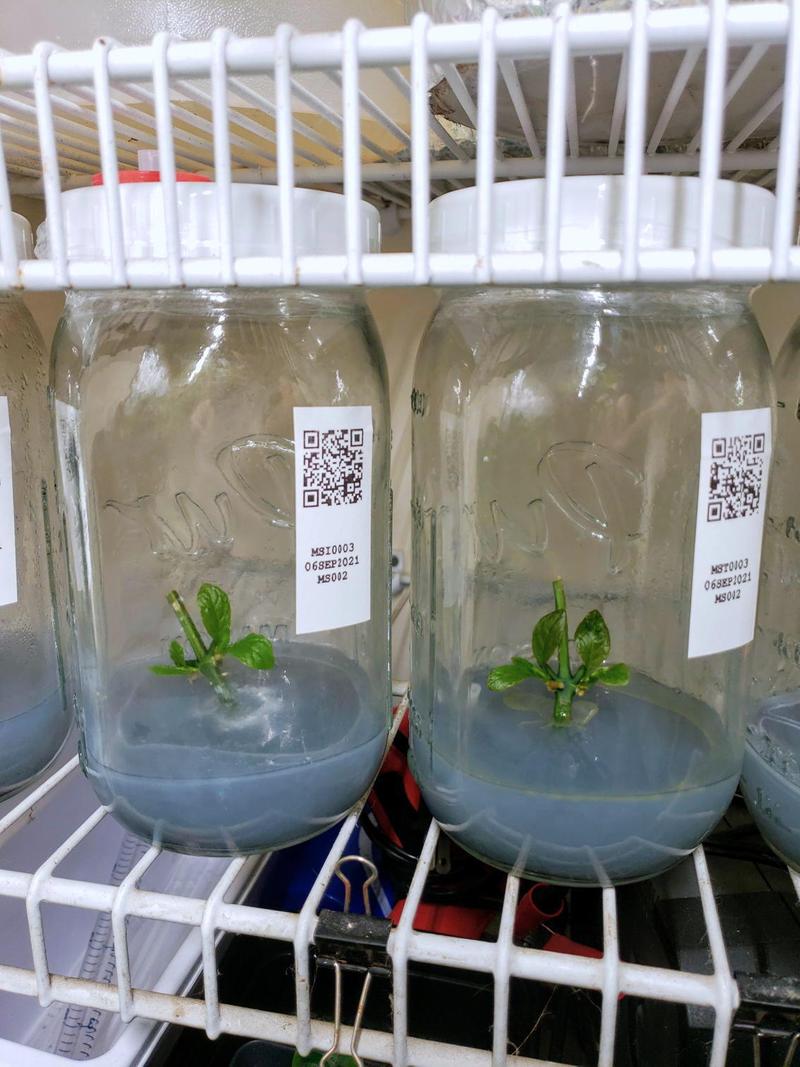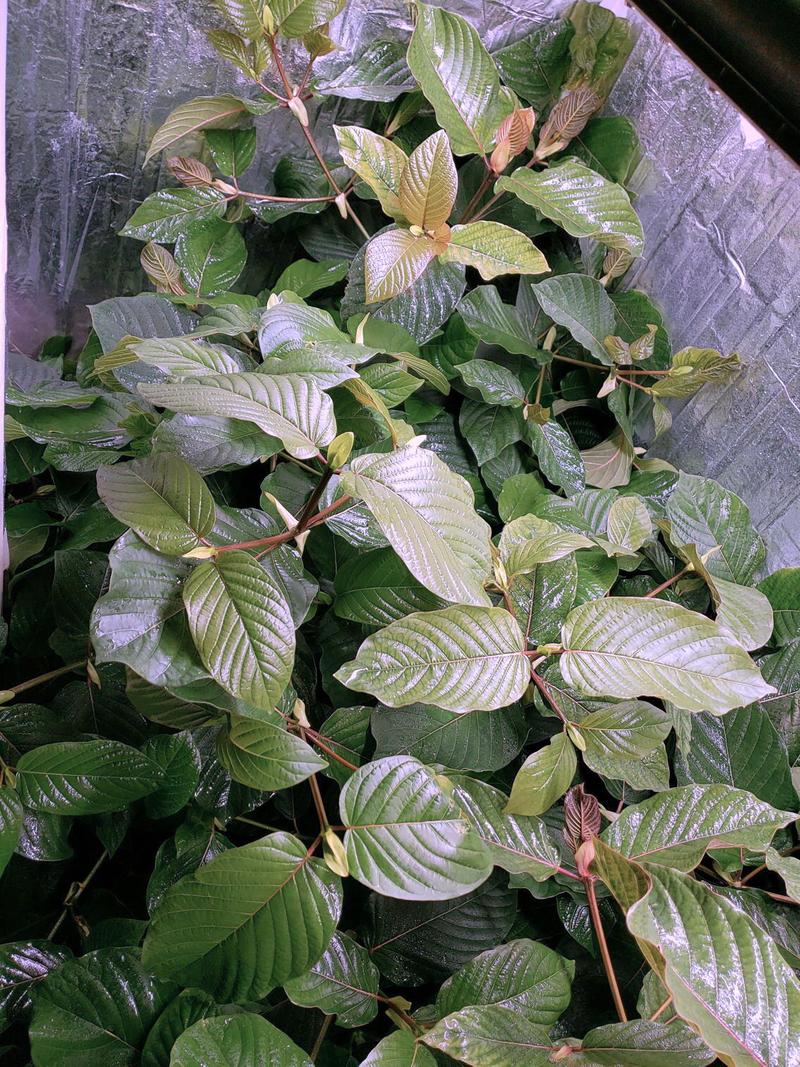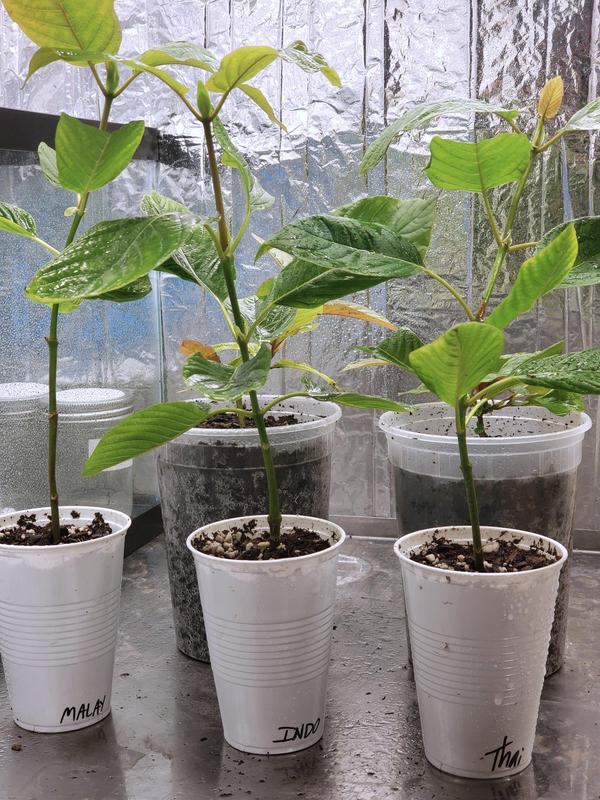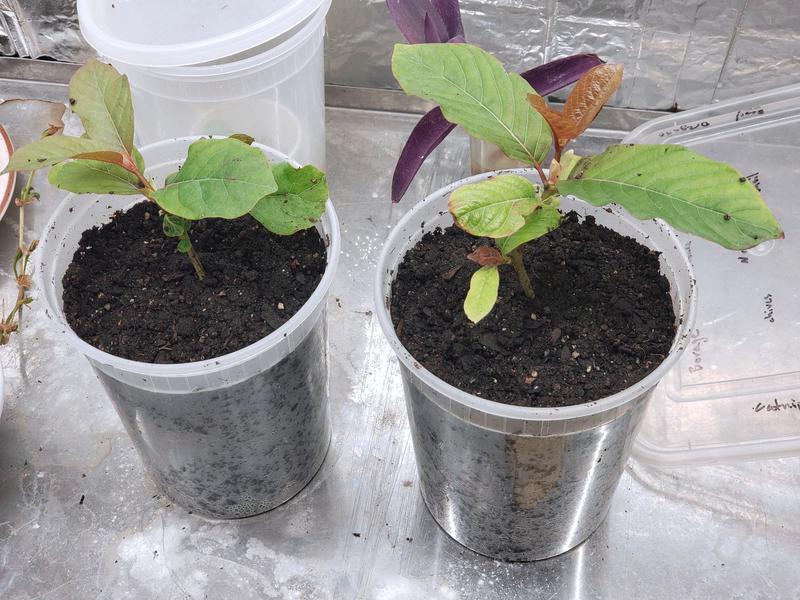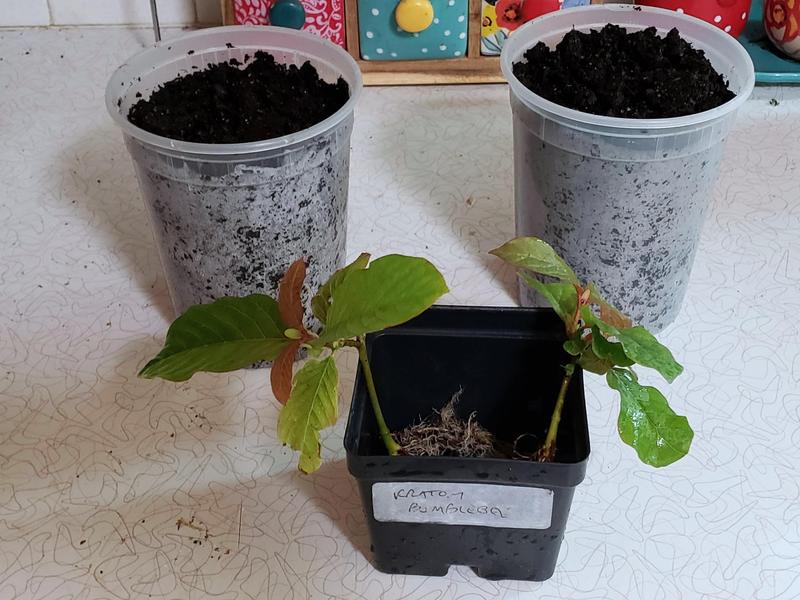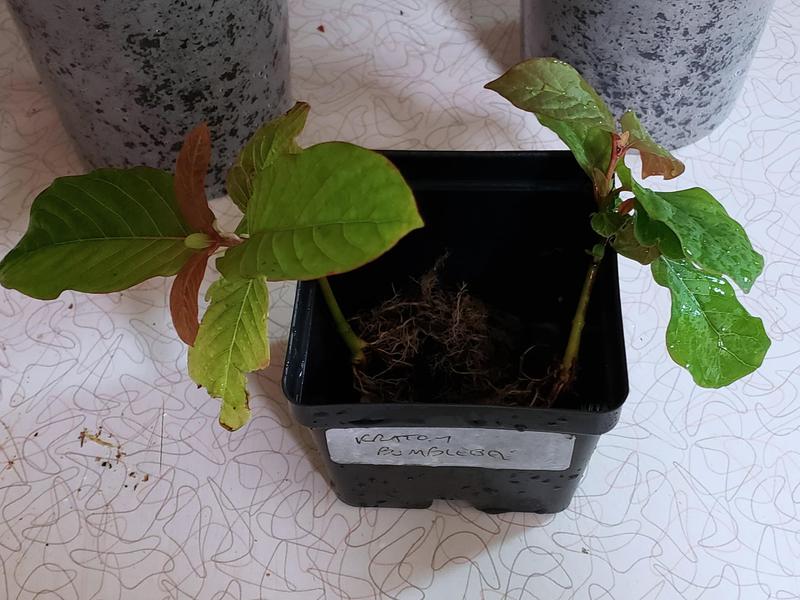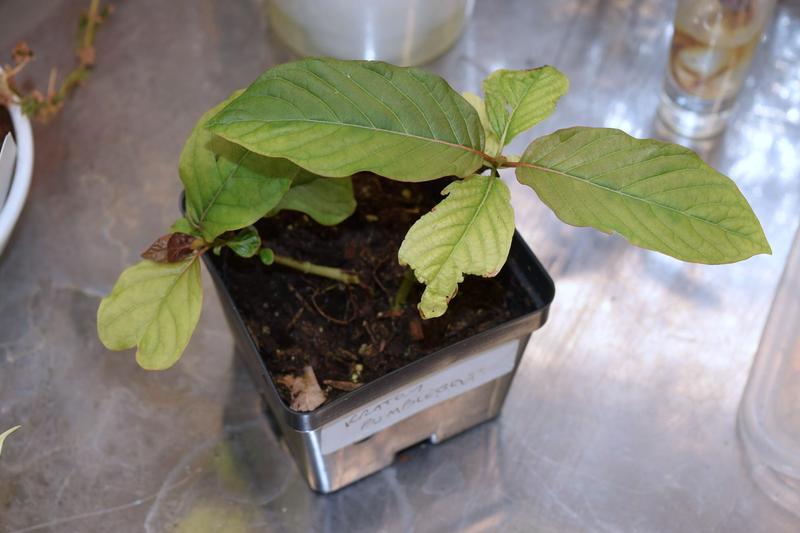Mitragyna speciosa
Mitragyna speciosa commonly known as kratom, is a medicinal tree native to Southeast Asia. The leaves are harvested, dried, powdered, and sold for their analgesic effects. The legality of speciosa is in flux, with several jurisdictions considering it an opioid in the same classification as heroin. Others have explicitly regulated it as a food or supplement.
The trees used in US M. speciosa research seem to have an order of magnitude lower concentration of mitragynine compared to commercial products imported from Asia. Several theories have been put foreward to explain the discrepancy.
Early research by Shellard et al. found an unusually high level of mitrajavine and javaphylline in their plant samples. The authors speculate this could have arisen from the use of “M. speciosa” seeds that were actually M. speciosa × M. javanica hybrids. Another hypothesis given was that mitragynine production increases with age, more specifically, that mitragynine is rapidly consumed in metabolic processes of growth.[1] Many researchers have since attempted to control for this factor by using only mature leaves or age-matched leaves for analysis.
Propagation
Germination
| media | germination | temperature °C | note | reference |
|---|---|---|---|---|
Speciosa seeds were germinated on hormone-free Woody Plant Media after disinfection with 70% ethanol for 5 min then 20% Clorox for 5 min. The seeds were incubated at 25°C with 16h illumination.[4][5]
Vegetative
1000ppm IBA in dry powder treatment (Hormodin 1) has been used for rooting stem cuttings.[6][7]
When pulse treatment at 100, 300, 500, and 700 ppm IBA or NAA for 1, 3, 5, or 7 minutes were examined for ex-vitro rooting of parvifolia plantlets, 90% (highest) rooting was seen in 500 ppm IBA for 5 minutes.[8]
In-Vitro
| basal media | supplements | source | target | note | reference |
|---|---|---|---|---|---|
Cultivation
| Planting density (m-2) | inter-row space (cm) | intra-row space (cm) | note | reference |
|---|---|---|---|---|
Plant height, width, total leaf area, number of leaves, and dry mass are greater when cultivated in a greenhouse compared to outdoors in full sun. Cultivation under shade cloth improves these factors slightly. The cultivation conditions were largely uncontrolled, further obfuscating the results.[7]
Speciosa can be grown using aquaponics.[9]
Harvest
Speciosa leaves have a drying index of about 3.4.[10]
Harvest time significantly affects alkaloid levels in speciosa leaves across 134 samples of plantation trees in Thailand.[10]
In a preliminary examination of post-harvest fermentation and drying techniques, no consistent trend arose in mitragynine concentration among the various combinations tested. This included cutting, deveining, and drying at 25/30/68/80°C.[11]
Some harvesting suggestions from an American kratom farm.[12]
Yield
| product | source | yield per season (kg/ha) | note | reference |
|---|---|---|---|---|
| product | source | yield per plant | note | reference |
|---|---|---|---|---|
Soilless
Soil
| soil type | pH | C-content % | precipitation | temperature (°C) | altitude (m) | note | reference |
|---|---|---|---|---|---|---|---|
Fertilization
| type | rate | time | note | reference |
|---|---|---|---|---|
| Osmocote slow-release 15-9-12 | 0/4/6.5/8.4 g/L | transplant | fertilization | [6] |
Alkaloid concentration by mass is independent of fertilizer application rate (Osmocote).[6]
However, soil concentrations of P, Ca, Mg, Fe, and Mn are associated with higher alkaloid content. Ca is significantly correlated with total alkaloid production, mitragynine, paynantheine, and speciogynine concentration.[10]
Osmocote 15-9-12 slow-release fertilizer can be used for M. speciosa cultivation for soilless cultivation in containers.[6][7]
Tree height, width, trunk diameter, leaf number, leaf area, and leaf dry mass increase dose-dependently with increased fertilizer application rates. Of special importance, leaf dry mass increased 10-fold in the high-dose fertilizer (Osmocoat 15-9-12; 8.4 g/L) trial compared to the control group that was not fertilized. This application rate was not associated with any observable toxicity symptoms. Since there was no decrement in alkaloid concentration in response to fertilization, total harvestable alkaloids increased similarly.[6]
Temperature
The highest levels of alkaloids, mitragynine in particular, in speciosa plantation trees are found in leaves harvested in the late summer, between the hot and rainy seasons in Thailand.[10]
Lighting
| fixture type | photoperiod | illumination | note | reference |
|---|---|---|---|---|
Total alkaloid concentration by mass is independent of lighting (full sun, greenhouse unshaded, greenhouse shaded). However, shaded conditions maximize the concentration of mitragynine specifically as well as the total leaf area leading to an almost triple yield compared to full sun conditions.[7]
Speciosa exhibits light capture optimization by increasing specific leaf area and total chlorophyll content (specifically chlorophyll b) in response to shaded conditions. This indicates that speciosa is a shade-tolerant species.[7]
Pests
Aphids are a potential pest of speciosa.[13]
Ecology
Apis sp. is attracted to the flowers of speciosa.[14]
Morphology
| character | measurement | unit | notes | reference |
|---|---|---|---|---|
| leaf dry weight | 0.6 ± 0.1 | g | infraspecific variation | [10] |
| leaf wet weight | 2.1 ± 0.5 | g | infraspecific variation | [10] |
| leaf length | 8-20 | cm | infraspecific variation | [10] |
| leaf width | 6-12 | cm | infraspecific variation | [10] |
| lamina size | 9-24 × 3.5-12.5 | cm | morphology | [15] |
| secondary vein angle | 25-85 | ° | morphology | [15] |
| indumentum of petiole | glabrescent | morphology | [15] | |
| interval of secondary veins | 0.4-1.6 | cm | morphology | [15] |
| indumentum of interpetiolar stipules | glabrescent along ridge | morphology | [15] | |
| flowering heads diameter | 3-4 | cm | morphology | [15] |
| indumentum of peduncle | glabrous | morphology | [15] | |
| interfloral bracteoles length | 5-6 | mm | morphology | [15] |
| calyx | unevenly and shallowly 3-,5-lobed | morphology | [15] | |
| calyx tube width | 2.5-3 | mm | morphology | [15] |
| calyx lobes shape | triangular, apex acute | morphology | [15] | |
| calyx lobes length | 0.3-0.7 | mm | morphology | [15] |
| corolla tube size | 5-6 × 2-3 | mm | morphology | [15] |
| stigma shape | mitriform | morphology | [15] | |
| stigma size | 2.2-3 × 1-1.5 | mm | morphology | [15] |
| indumentum on stalks of fruiting heads | glabrous | morphology | [15] | |
| fruits length | 5-10 | mm | morphology | [15] |
| type | briefly deciduous or evergreen | morphology | [15] | |
| height | 5-33 | m | morphology | [15] |
| girth | <190 | cm | morphology | [15] |
Mitragyna has 10 species. M. speciosa can be difficult to distinguish from other Mitragyna because substantial plastic phenotypic variation can occur. [3]
Roots
Stem
Speciosa bark is smooth or scaly and grey to greyish brown.[15]
Leaves
The stipules can be red or green colored. This coloration has no genetic discriminant and is likely due to some unknown difference between soil type or nutrient supply.[10]
Leaves opposite, decussate; laminas elliptic, narrowly elliptic, elliptic-oblong, ovate, sometimes obovate, 9–24 × 3.5–12.5 cm; apex acuminate, sometimes acute; base cuneate, obtuse, rounded, cordate, subcordate or truncate; margin undulate, sometimes distally unevenly dentate with 1–5 teeth on each side; chartaceous to subcoriaceous, dark green, glabrous or glabrescent above, paler, pubescent along veins or glabrescent below; midrib and secondary veins red, reddish green or pale green, raised below, secondary veins 10–17 pairs, 0.4–1.6 cm apart, departing from the midrib at an angle of 25°–85°, curving and connected in loops near the margin; tertiary veins distinctly scalariform; veinlets reticulate; petioles red, reddish green or pale green, 2–4.5 cm long, 1–3.5 mm in diam., shallowly grooved above, glabrescent; leaves turning yellow and falling off., Domatia present, densely hairy in the axil of secondary veins.[15]
Stipules interpetiolar, reddish green or green, keeled, elliptic, 3.5–6.5 × 1–2.5 cm; apex acute or obtuse; margin entire, glabrescent along ridge, with veins; inside with dense colleters interspaced with hairs at the base, colleters lanceolate.[15]
Inflorescence
Inflorescences consisting of globose, many-flowered flowering heads, terminal on main and lateral branches, arrangement like simple or compound dichasia; flowering heads 3–4 cm in diam.; peduncle 0.3–1.3 cm long, glabrous; common receptacle densely long hairy.[15]
Bracts one pair, small, leaf-like, subtending flowering heads elliptic, 2.3–8(–15) × 1–6.8 cm; apex acuminate or acute; base cuneate or attenuate; margin undulate; petioles 1.3–4.6 cm long. Interfloral bracteoles keeled, spathulate or linear-spathulate, 5–6 × 0.3–2 mm, apical part ciliate. Flowers fragrant.[15]
Calyx pale green, tubular, 1–1.5 × 2.5–3 mm, glabrous on both sides, unevenly and shallowly (3–)5-lobed, lobes triangular, 0.3–0.7 × 1–1.5 mm; apex acute; margin ciliate. Corolla creamy white to pale yellow, turning dark yellow to orangish yellow with age, hypocrateriform, 5–6 × 2–3 mm, glabrous outside, densely long hairy at throat inside, hairs protruding from the corolla throat, 5-lobed, lobes narrowly elliptic, 3–4.5 × 1–2 mm; apical part involute and fused like toe box, glabrous outside, glabrescent inside, with a median vein. Stamens 5; filaments 0.3–0.5 mm long; anthers 1.7–2.2 mm long, protruding from the corolla throat. Ovary obovoid, 2–2.2 × 1.5–2.2 mm; style slender, 0.9–1.3 cm long, glabrous; stigma mitriform, 2.2–3 × 1–1.5 mm; apical part of style and stigma protruding from the corolla throat.[15]
Seeds
Fruiting heads 1.5–2.7 cm in diam.; stalks 0.4–1.5 cm long, glabrous. Fruits obovoid or turbinate, 0.5–1 cm × 2–5 mm, green or dark green, turning brown or blackish brown when dry, glabrous, with persistent calyx. Seeds numerous, brown, flattened, narrowly elliptic, 3–4 × 0.3–0.6 mm (include wing), winged at both ends, acuminate at both ends or lower wing bifid.
Phytochemistry
| compound | source | concentration (mg/g dry weight) | note | reference |
|---|---|---|---|---|
| mitragynine | leaf | 21.6 (49.4 - 7.4) | infraspecific variation | [10] |
| mitragynine | leaf | 1.5-2.9 | harvest | [11] |
| total alkaloids | leaf | 5.81-12.2 | infraspecific variation | [16] |
The ratio of mitragynine to paynantheine to speciogynine is typically about 7:1:1.[10]
There is no significant difference in alkaloid distribution or concentration between red-veined and green-veined leaves.[10]
The pKa of mitragynine is ~8.1.[17]
| pH | solubility (µg/ml) | logD n-octanol/water coefficient | | – | —————— | ——————————– | | 4 buffered | 3500 ± 1 | 0.78 | | 7 buffered | 88.9 ± 1.6 | 1.73 | | neutral water | 64.6 ± 1.2 | 1.70 (logP) | | pH 9 | 18.7 ± 0.4 | 1.56 | [17]
Mitragynine is potentially unstable in acidic conditions. Only 91.8% and 88.8% of mitragynine was recovered after 6 and 24 hours at pH 4.[17]
[16] [18] [10] [19] [20] [6] [21] [22] [23] [24] [25] [26] [27] [28] [29] [30] [31] [32] [33] [34] leksungnoen_variations_2022
Infraspecific Variation
Bumblebee and Rifat varieties (live plants obtained from World Seed Supply) can be accurately distinguished by LDA of their chemical extracts.[35]
[36] [16] leksungnoen_variations_2022
Biosynthesis
[7] [24] [37] charoonratana_molecular_2013 wu_discovering_2023
Distribution
Mitragynine is produced in the leaves.[38] The highest accumulation of alkaloids is in the leaf palisade and spongy parenchyma as well as the petiole cortex and pith.[10]
[39] [1] [40] [41] [30] kitajima_new_2006 charoonratana_molecular_2013
Timecourse
veeramohan_comparative_2023
Improvement
| trait | improvement status | reference |
|---|---|---|
Identification
| variety | description | reference |
|---|---|---|
| Bumblebee | [35] | |
| Rifat | [35] |
Rifat “Thai” shares 99% sequence similarity with NCBI GenBank database accessions of M. speciosa.[36]
- Kra thom (กระท่อม)
- thom (ท่อม)
- i thang (อีถ่�ง)
Inheritance
Methods
| type | note | reference |
|---|---|---|
| HPLC-DAD/MS; GC-MS | infraspecific variation | [16] |
MeOH/H2O Extraction[16]
- place 50g ground dry leaf in a 1L round bottom flask
- add 500 ml MeOH/H2O 1:1 (v/v)
- stir for 24 hours
- filter through paper on Büchner funnel
- evaporate MeOH under vacuum (leave H2O)
Purification[16]
- add 0.1 M NH4OH solution until pH reaches 9
- extract with dichloromethane
- evaporate DCM to yield crude extract
- extract with 0.1 N HCl
- wash with petroleum ether 3×
- add 0.1 M NH4OH solution until pH reaches 9
- recover final precipitated alkaloids by paper filtration
- alternatively: extract with dichloromethane and evaporate under vacuum
Mitragynine can be visually identified by TLC with UV visualization at a concentration of 0.158 mg/ml (hexane:ethyl acetate on silica).[43]
SPAD meters can accurately determine the leaf chlorophyll content of speciosa.[7]
Extraction with a methanol/water 1:1 mixture yielded 0.94-1.43% (w/w) crude extract. Dichloromethane washes during subsequent acid-based purifications resulted in a loss of nearly 10% of total alkaloid yield and worse mitragynine purity.[16] This is likely the result of the relatively low partition coefficient of mitragynine (~1.7).[17]
Boiling hot water is comparable to methanol for extracting mitragynine, paynantheine, and speciogynine. However, methanol extraction gives a 10-fold yield of material indicating a substantial coextraction of other, possibly undesirable, compounds including chlorophyll. Water extraction could be viable on an industrial scale.1[18] Other research has suggested that mitragynine is poorly soluble in basic/neutral water and also labile in acidic water. These factors should be taken into account when designing extration protocols.[17]
Tea is often recommended as a method of ingestion for speciosa.[44] The maximum solubility of mitragynine in a 250ml serving of acidified water at 37°C would be approximately 900 mg or roughly the content of 40 grams of dry leaf. Likely the solublity would be even higher at elevated temperature. The maximum solubility in neutral water is ~16 mg or approximately 1 gram.[17] This indicates that tea without acidification is a potentially unsuitable method for consuming speciosa.
An example of speciosa flower pollination.[45]
[18] [20] [21] [22] [23] [46] [47] [32] [33] [42] kong_evaluation_2017 avery_comparative_2019 kumarnsit_effect_2007 kitajima_new_2006 orio_uae_2012 goh_accelerated_2021 sakaran_insight_2014 lelono_extraction_2021 bowe_endogenous_2024
History & Society
The US Food and Drug Administration (FDA) considers speciosa and speciosa-containing products to be a “new dietary ingredients” without adequate safety information for public sale.[48] Speciosa products in the US may be detained without examination.[49]
Trade groups, such as the American Kratom Association, have lobbied to pass several state measures designed to protect consumers and kratom alike.[50][51]
[52] [37] sakaran_insight_2014 hassan_kratom_2013 sabran_empowering_2023 charoenratana_attitudes_2021 hayden_griffin_examining_2018
Work Log
08 Jan 2023
MS Malay mother tree has suffered no apparent ill effects from the acetamiprid treatment. I am going to treat the other 4 trees. The two smaller trees in fabric pots will only get a 10mg a.i. dose (2 ml OBBG in 170ml).
05 Jan 2023
Neem treatments are not working. My mother trees are suffering. Going to try “soil” application of acetamiprid. ORTHO Bug B Gon has 0.5% acetamiprid (5mg per ml). I have used 12 ml/l 150 ml (9mg a.i.) per tree for foliar application. Systemic treatment is less efficient so I will probably bump that to 15mg (3ml OBBG in 250ml). This is a blind guess.
Treated MS Malay tree because the genetics are conserved.
28 Aug 2022
FLOWER!!!
The MSM001 tree is about 1.5 m tall and 1.2 m at max diameter right now. The trunk is about 28 mm in diameter at the base.
21 Aug 2022
Applied acetamiprid (12 ml/L; 450 ml over 3 plants and three dozen cuttings).
The new cuttings are looking great. Since these were treated with a store-bought rooting hormone powder instead of my mix, it seems the latter is responsible for the poor survival in past experiments.
17 Aug 2022
Replaced the LED strip light with COBs instead. That way each plant can receive its light instead of being blocked by each other.
Added a bit of support for the MST001 tree. It kept falling over or into the bucket.
28 Jul 2022
Transferred the verm cuttings to pots. Three of MST and MSM have survived. Abysmal.
Took some more cuttings of MSM001. This time I used rockwool and went with a commercial rooting hormone powder.
A lot of leaves get thrown away while taking cuttings. I could probably eat them, but whatever.
I applied malathion (4ml 50% malathion per liter + a drop of dish soap; 300ml used) to the indoor trees as a second course for the mealybugs. About 4 weeks ago I applied acetamiprid with great success. I noticed a few mealybugs returned in the last few days. Switching from a neonicotinoid to an acetylcholinesterase inhibitor should reduce resistance.
None of the other plants in my house have any bugs at all. Hopefully with these mealybugs irradicated, I shall once again have a clean household.
Side note: The LED light strip doesn’t have great coverage now that MSM001 has grown so large. I should replace it or find a supplement.
31 Jul 2022
MST is getting too tall. Maybe I will try air-layering…
15 Jul 2022
The Kratky kratom needs to be moved to soil. The small net cups are constricting the roots severely.
The plants before moving them to fabric pots.
The bound roots.
I had to cut them out of the net cups using a pair of snips.
Done. MSB in a 5-gallon fabric pot. MSI in 3 gal.
12 Jul 2022
Finally got around to taking some good photos of the seeds pods from Thailand.
As received:
A close-up of an empty pod:
Seeds and chaff:
Seeds only:
05 Jul 2022
Bought two pods from a redditor who imported them from Thailand.
28 Jun 2022
MSB001 is looking real scraggly out their without much light.
11 Jun 2022
Started some cuttings of each tree. Pulse treatment. Sterile vermiculite. Neem oil treatment.
03 Jun 2022
Some large leaves are developing on MSM001.
25 May 2022
Measuring the trunk diameter for MSM001:
MST001:
MSB001:
17 Apr 2022
Trying to root a few cuttings using the jet-nebulizer as a mist maker. Pulse hormone treatment.
06 Apr 2022
Trying a few cuttings in the fungi grow tent. Pulse treatment.
24 Mar 2022
The air-layering seems to have failed. No roots have developed. The tree looks entirely dead.
21 Mar 2022
Kratky MSI and MSB plants before being transferred to larger containers.
16 Mar 2022
Just some root porn:
16 Apr 2022
Most of the leaves of the 6 cuttings have died. A few of the leaf buds are still green, but overall I will call this a failed experiment. I do not know if this is the result of the environment or the PGR treatment. Since a similar thing happened to the in vitro speciosa after putting them into the fungi fruiting chamber, I think the former is likely.
Attempt #2.
1:1:1 mix (v/v) perlite, vermiculite, and sphagnum peat moss (1 qt. each; 442g total). Added 1L 1/4 strength MasterBlend hydro nutrients (to approximately 60% hydration). Sterilized in PC for 45 minutes at 15psi.
At the same time, a 6qt. clear sterlite container was disinfected with 10% bleach.
05 Apr 2022
Starting 6 cuttings from Bumblebee speciosa plants. There will be two groups: coconut coir and rockwool cubes. After the selection of explants, they are:
- agitated for 1 minute in soapy water
- rinsed for 5 minutes in running tap water
- drained
- disinfected with 70% ethanol for 1 minute, with agitation
- rinsed
- disinfected with 0.6% sodium hypochlorite for 2 minutes
- rinsed
- dipped 500 ppm IBA + 250 ppm NAA + 1000 ppm sucrose solution (1.25 ml stock solution in 25 ml) for 5 minutes
Coir and rockwool cubes were sterilized in PC at 10psi for 30 minutes (not perfect). The cuttings were placed in the fungi fruiting chamber because of the 99% constant humidity. Media was supported by plastic cell trays.
18 Mar 2022
Full water change.
09 Feb 2022
For a couple of months, I have noticed slow/no growth on the Indo tree. The lower stems have been completely devoid of leaves and the apical tips have withered. I thought that this plant was just particularly sensitive to the low humidity. Nope. It is completely overwhelmed by root rot.
So I decided to try air-layering to save the tree.
I removed a 4cm section of bark between two nodes. The cut was made far enough above the existing roots so that no transmission could occur. I make sure to cut through to the cambium. I sprinkled rooting hormone into the bag before mounting. This is probably necessary because of the lack of leaves.
I used 100% coco coir in a plastic bag (autoclaved for sterility). The bag is stuffed full and sealed shut with a bit of tape. When mounting, the bag is sliced open the full length on one side, like a hot dog bun. The resultant “bun” is placed surrounding the cut and wrapped with plastic wrap to seal it.
Foil is added to minimize light and prevent algae growth.
The tree is 115cm tall.
09 Jan 2022
Full nutrient change.
I have been doing spot treatments with acetamiprid over the last couple of weeks. I also did a mild treatment over all of the plants today.
27 Dec 2021
19 Dec 2021
The second treatment of acetamiprid is today. 12 ml/L Ortho Bug B Gon 0.5% acetamiprid. Approximately 300ml to cover all four trees completely. I paid special attention to the leaf buds this time since mealybugs seem to like to hide in the enclosed bud.
The last couple of weeks have seen some sporadic mealybug infestations. They confined themselves to the base of the leaf buds at first. They appeared to congregate inside the leaf buds, as newly split open leaves were often infested.
I have been inspecting the trees daily to remove the bugs with isopropyl alcohol-soaked cotton swabs. That has kept them at bay for a while, but they seem to have gotten worse in the last few days.
I will reapply in 7-14 days if the mealybugs return. I don’t consume any Kratom, but if I did I would wait at least 14 days after the last application.
07 Dec 2021
30 Sep 2021
22 May 2021
18 May 2021
17 May 2021
08 May 2021
-
Details unknown until the full-text is released. ↩
Bibliography
- E. J. Shellard, P. J. Houghton, and M. Resha, “The Mitragyna Species of Asia XXXII: The Distribution of Alkaloids in Young Plants of Mitragyna Speciosa KORTH Grown from Seed Obtained from Thailand,” Planta Medica, vol. 34, no. 7, pp. 253–263, Nov. 1978.
doi: 10.1055/s-0028-1097448.
Thieme E-Books & E-Journals
- S. Ramanathan et al., “Chapter 5 - Kratom (Mitragyna Speciosa Korth.): A Description on the Ethnobotany, Alkaloid Chemistry, and Neuropharmacology,” in Studies in Natural Products Chemistry, vol. 69, Atta-ur-Rahman, Ed. Elsevier, 2021, pp. 195–225.
doi: 10.1016/B978-0-12-819487-4.00003-3.
Mitragyna speciosa (kratom), a Southeast Asian plant belonging to the Mitragyna genus, has a long history of traditional uses. There are several therapeutic properties attributed to kratom such as energy booster, pain reliever, mood enhancer, remedy for various ailments, and management of opiate addiction. In recent years, kratom leaves and derivatized botanical products (e.g., extracts, solutions) are being sold as dietary supplements and marketed worldwide via the internet for the management of pain, anxiety, and depression. Indole and oxindole alkaloids are the major chemical constituents that are most likely implicated in the pharmacological effects of kratom products. In Western countries, other than in Southeast Asia, several issues have been alarming, such as adulteration, substitution, and spiking the plant material with neuropharmacological and illicit substances. This chapter provides a summary of the ethnobotany and alkaloid chemistry of kratom including plant biosynthesis and chemical synthesis of alkaloid molecules. Recent developments in the alkaloid detection methods for kratom profiling and authentication of kratom products are also discussed in this chapter. Additionally, this chapter discusses a compilation of the available information from the literature related to the CNS exposure and interaction of major kratom alkaloids.
- P. N. Brown, J. A. Lund, and S. J. Murch, “A Botanical, Phytochemical and Ethnomedicinal Review of the Genus Mitragyna Korth: Implications for Products Sold as Kratom,” Journal of Ethnopharmacology, vol. 202, pp. 302–325, Apr. 2017.
doi: 10.1016/j.jep.2017.03.020.
Ethnopharmacological relevance The genus Mitragyna (Rubiacaeae) has been traditionally used in parts of Africa, Asia and Oceania. In recent years, there has been increased interest in species of Mitragyna with the introduction of products to western markets and regulatory uncertainty. Aim of the study This paper reviewed the traditional ethnomedicinal uses of leaves for species belonging to the genus Mitragyna with reference to the botany and known chemistry in order to highlight areas of interest for products currently being sold as kratom. Materials and methods A literature search was conducted using Web of Science, Google Scholar, the Royal Museum for Central Africa, Internet Archive, Hathi Trust, and Biodiversity Heritage Library search engines in the spring of 2015, fall of 2016 and winter of 2017 to document uses of bark, leaf and root material. Results Leaves of M. speciosa (kratom) had the most common documented ethnomedicinal uses as an opium substitute or remedy for addiction. Other species of Mitragyna were reportedly used for treating pain, however the mode of preparation was most often cited as topical application. Other uses of Mitragyna included treatment of fever, skin infections, and as a mild anxiolytic. Conclusions Mitragyna species have been used medicinally in various parts of the world and that there is significant traditional evidence of use. Modern products that include formulations as topical application of liniments, balms or tinctures may provide effective alternatives for treatment of certain types of pains. Future research is required to establish safety and toxicology limits, medicinal chemistry parameters and the potential for different physiological responses among varying genetic populations to support regulatory requirements for Mitragyna spp.
- T. Charoonratanaa, J. Wungsintaweekul, P. Pathompak, M. I. Georgiev, Y. H. Choi, and R. Verpoorte, “Limitation of Mitragynine Biosynthesis in Mitragyna Speciosa (Roxb.) Korth. through Tryptamine Availability,” Zeitschrift Fur Naturforschung. C, Journal of Biosciences, vol. 68, no. 9-10, pp. 394–405, 2013 Sep-Oct.
https://pubmed.ncbi.nlm.nih.gov/24459773/.
Metabolite profiles of Mitragyna speciosa were determined by means of 1H NMR-based and HPLC-based analyses. The results indicated that high contents of secologanin, caffeic acid, gallic acid, epigallocatechin, and mitragynine were accumulated in leaves. In M. speciosa, feedings of tryptamine, tryptophan, phenylalanine or tyrosine significantly increased the mitragynine contents. Feedings of tryptamine and loganin also enhanced the mitragynine accumulation, but feeding of loganin only did not affect the mitragynine level. The mRNA levels of anthranilate synthase alpha subunit (ASA), tryptophan decarboxylase (TDC), and strictosidine synthase (STR) were measured by quantitative real-time polymerase chain reaction (RT-qPCR) in control plants and those exposed to methyl jasmonate (MJ; 10 microM). All genes responded to MJ after a 24-h treatment. The mitragynine contents were also enhanced and corresponded to the transcript levels. From the present results we conclude that a high content of secologanin together with a undetectable level of tryptamine in M. speciosa feature the limitation of mitragynine biosynthesis. Additionally, expression of all the genes limits production of an essential precursor for mitragynine production.
- J. Wungsintaweekul, J. Choo-malee, T. Charoonratana, and N. Keawpradub, “Methyl Jasmonate and Yeast Extract Stimulate Mitragynine Production in Mitragyna Speciosa (Roxb.) Korth. Shoot Culture,” Biotechnology Letters, vol. 34, no. 10, pp. 1945–1950, Oct. 2012.
doi: 10.1007/s10529-012-0968-6.
Mitragynine is a pharmacologically-active terpenoid indole alkaloid found in Mitragyna speciosa leaves. Treatment with methyl jasmonate (10 μM) for 24 h and yeast extract (0.1 mg/ml) for 12 h were the optimum conditions of elicitation of mitragynine accumulation in a M. speciosa shoot culture. The former elicitor gave 0.11 mg mitragynine/g dry wt. Tryptophan decarboxylase and strictosidine synthase mRNA levels were enhanced in accordance with mitragynine accumulation.
- M. Zhang et al., “Effects of Nutrient Fertility on Growth and Alkaloidal Content in Mitragyna Speciosa (Kratom),” Frontiers in Plant Science, vol. 11, 2020.
doi: 10.3389/fpls.2020.597696.
Leaves harvested from the Southeast Asian tree Mitragyna speciosa (kratom) have a history of use as a traditional ethnobotanical source of medicine to combat fatigue, improve work productivity, and to reduce opioid-related withdrawal symptoms. Kratom leaves contain an array of alkaloids thought to be responsible for the bioactivity reported by users. Interest in the consumptive effects of kratom has led to its recent popularity and use in North America, Western Europe, and Australia. Although the chemistry and pharmacology of select kratom alkaloids are understood, studies have not examined the influence of production environment on growth and alkaloidal content. To directly address this need, 68 kratom trees were vegetatively propagated from a single mother stock to reduce genetic variability and subjected to four varying fertilizer application rates. Leaves were analyzed for chlorophyll concentration, biomass, and alkaloidal content to understand the physiological response of the plant. While increasing rates of fertilizer promoted greater plant growth, relationships with alkaloidal content within leaves were highly variable. Fertility rate had little influence on the concentration of mitragynine, paynantheine, speciociliatine, mitraphylline, and corynoxine per leaf dry mass. 7-Hydroxymitragynine was below the lower limit of quantification in all the analyzed leaf samples. Low to medium rates of fertilizer, however, maximized concentrations of speciogynine, corynantheidine, and isocorynantheidine per leaf dry mass, suggesting a promotion of nitrogen allocation for secondary metabolism occurred for these select alkaloids. Strong correlations (r2 =0.86) between extracted leaf chlorophyll and rapid, nondestructive chlorophyll evaluation (SPAD) response allowed for development of a reliable linear model that can be used to diagnose nutrient deficiencies and allow for timely adjustment of fertilization programs to more accurately manage kratom cultivation efforts. Results from this study provide a greater understanding of the concentration and synthesis of nine bioactive alkaloids in fresh kratom leaves and provide foundational information for kratom cultivation and production.
- M. Zhang et al., “Plant Growth and Phytoactive Alkaloid Synthesis in Kratom [Mitragyna Speciosa (Korth.)] in Response to Varying Radiance,” PLOS ONE, vol. 17, no. 4, p. e0259326, Apr. 2022.
doi: 10.1371/journal.pone.0259326.
Leaves harvested from kratom [Mitragyna speciosa (Korth.)] have a history of use as a traditional ethnobotanical medicine to combat fatigue and improve work productivity in Southeast Asia. In recent years, increased interest in the application and use of kratom has emerged globally, including North America, for its potential application as an alternative source of medicine for pain management and opioid withdrawal syndrome mitigation. Although the chemistry and pharmacology of major kratom alkaloids, mitragynine and 7-hydroxymitragynine, are well documented, foundational information on the impact of plant production environment on growth and kratom alkaloids synthesis is unavailable. To directly address this need, kratom plant growth, leaf chlorophyll content, and alkaloid concentration were evaluated under three lighting conditions: field full sun (FLD-Sun), greenhouse unshaded (GH-Unshaded), and greenhouse shaded (GH-Shaded). Nine kratom alkaloids were quantified using an ultra-performance liquid chromatography-tandem mass spectrometry (UPLC-MS/MS) method. Greenhouse cultivation generally promoted kratom height and width extension by 93–114% and 53–57%, respectively, compared to FLD-Sun. Similarly, total leaf area and leaf number were increased by 118–160% and 54–80% under such conditions. Average leaf size of plants grown under GH-Shaded was 41 and 69% greater than GH-Unshaded and FLD-Sun, respectively; however, no differences were observed between GH-Unshaded and FLD-Sun treatments. At the termination of the study, total leaf chlorophyll a+b content of FLD-Sun was 17–23% less than those grown in the greenhouse. Total leaf dry mass was maximized when cultivated in the greenhouse and was 89–91% greater than in the field. Leaf content of four alkaloids to include speciociliatine, mitraphylline, corynantheidine, and isocorynantheidine were not significantly impacted by lighting conditions, whereas 7-hydroxymitragynine was below the lower limit of quantification across all treatments. However, mitragynine, paynantheine, and corynoxine concentration per leaf dry mass were increased by 40%, 35%, and 111%, respectively, when cultivated under GH-Shaded compared to FLD-Sun. Additionally, total alkaloid yield per plant was maximized and nearly tripled for several alkaloids when plants were cultivated under such conditions. Furthermore, rapid, non-destructive chlorophyll evaluation correlated well (r2 = 0.68) with extracted chlorophyll concentrations. Given these findings, production efforts where low-light conditions can be implemented are likely to maximize plant biomass and total leaf alkaloid production.
- A. K. Patel, D. Lodha, and N. S. Shekhawat, “An Improved Micropropagation Protocol for the Ex Situ Conservation of Mitragyna Parvifolia (Roxb.) Korth. (Rubiaceae): An Endangered Tree of Pharmaceutical Importance,” In Vitro Cellular & Developmental Biology - Plant, vol. 56, no. 6, pp. 817–826, Dec. 2020.
doi: 10.1007/s11627-020-10089-6.
Mitragyna parvifolia (Roxb.) Korth., commonly known as “Kadam,” is an endangered and pharmaceutically valued tree of the family Rubiaceae. The numerous medicinal properties are attributed to the various alkaloids of this plant. Poor seedling survival (due to very small size of seeds, approximately 10,000 per gm), overexploitation and habitat destruction are the major constraints in conserving the wild stocks of this species. This paper reports a significant, improved, and repeatable micropropagation protocol of M. parvifolia using nodal explants of a mature tree. Nodal explants harvested during spring season from the lopped tree differentiated the maximum number of axillary shoots (5.3\,± 0.82 per node) on full-strength Murashige and Skoog (MS) medium containing 3.0 mg L−1 6-benzylaminopurine (BAP) and additives (25 mg L−1 each of adenine sulfate, L-arginine, and citric acid and 50 mg L−1 ascorbic acid). Shoots were amplified in vitro through (1) recurrent transfer of mother explants and (2) subculturing on fresh nutrient medium. The greatest number of shoots (13.4\,± 1.26) with an average length of 6.2\,± 1.03 cm was produced after 4 wk on MS medium containing 0.5 mg L−1 BAP, 0.25 mg L−1 kinetin (Kin), 0.1 mg L−1 Indole-3-acetic acid (IAA), additives, 100 mg L−1 activated charcoal (AC), and 0.8% (w/v) agar. This is the first report of concurrent ex vitro rooting and acclimatization (CEVRA) in M. parvifolia. About 90% micropropagated shoots rooted ex vitro on pulse treatment of 500 mg L−1 Indole-3-butyric acid (IBA; for 5 min) and produced 8.5\,± 0.97 roots per shoot with an average length of 9.40\,± 1.06 cm, after 5 wk. Over 80% of CEVRA plantlets were successfully transplanted to the soil in field. The defined protocol can be employed for conservation ex situ and restoration/rehabilitation/reintroduction in situ of M. parvifolia.
- st-qp4mr, “Grow Kratom in Aquaponics?” Aug-2017.
https://www.youtube.com/watch?v=RZBz-GYUeH4.
Can you grow Kratom in Aquaponics? Where to Buy the Lights: Phillips 23w CFL 6500k: https://amzn.to/2JpFSn9 Phillips 23w Cfl 2700K: https://amzn.to/2Q2LOVW Great place to get your kratom is here.. I recommend the RED MD or RED VEIN THAI or any of the red strains for pain relief, opiate addiction relief, or anxiety depression. This In my opinion will get your life back! Check with your doctor before you try. https://www.lifeforcek.com/ Also for more science and info on kratom please check out this site and join the fight to keep kratom legal https://www.americankratom.org/ Disclosure: This post may contain ebay or amazon affiliate links, meaning I get a commission if you decide to make a purchase through my links, at no cost to you.
- N. Sengnon et al., “Seasonal and Geographic Variation in Alkaloid Content of Kratom (Mitragyna Speciosa (Korth.) Havil.) from Thailand,” Plants, vol. 12, no. 4, p. 949, Jan. 2023.
doi: 10.3390/plants12040949.
The objective of this study was to obtain data on the distribution of alkaloids in kratom plants grown in Thailand. Two collections were performed, covering the southern, central, and northern regions of Thailand and different seasons. The contents of alkaloids, including mitragynine (MG), paynantheine (PAY), and speciogynine (SG), were determined using the validated HPLC method. The 134 samples in the first collection were collected from Nam Phu subdistrict, Ban Na San, Surat Thani, Thailand, during June and October 2019 and January 2020. The maximum mitragynine content was 4.94% w/w in June (late summer), and the minimum content was 0.74% w/w in October (rainy season). To expand the study area after kratom decriminalization, 611 samples were collected in June–August 2021, October–December 2021, and January–April 2022. The accumulation of MG ranged from 0.35 to 3.46% w/w, 0.31 to 2.54% w/w, and 0.48 to 2.81% w/w, respectively. The meteorological data supported the climate’s effect on alkaloid production. Soil analysis revealed the importance of Ca and Mg in promoting alkaloid production. Geographical locations played a role in the variation of MG in kratom leaves, but did not affect the color of leaf veins. In conclusion, the present study suggested that the alkaloid content in kratom diverges based on seasonal and geographical origin.
- B. J. Pearson et al., “Preliminary Examination of Mitragynine and 7-Hydroxymitragynine Synthesis in Response to Production Environment and Postharvest Techniques of Mitragyna Speciosa,” Acta Horticulturae, no. 1274, pp. 89–96, Mar. 2020. doi: 10.17660/ActaHortic.2020.1274.10.
- K. T. Tree, “@BotanicalQueens Collab! - Explaining American Kratom Leaf.” Dec-2021.
https://www.youtube.com/watch?v=7BM0s2hoOtg.
For this video we are partnering with @BotanicalQueens on Youtube. Thank you so much Emily from for allowing us to come on and talk about American Kratom. And highlight one of our 11 year old 40ft pink vein kratom trees. It is one of the tallest and oldest kratom trees in the United States. In this video, we go over what our American Kratom nursery looks for in picking fresh organic American Kratom Leaf. How to shape your kratom trees growing at home for a long term viability when picking. What some of the differences when it comes to kratom. We encourage you to sit back, relax, and understand the intricacy’s of mature kratom leaf. We hope that you learn something. Solicitation notice: Please do not ask where to buy in the comments. These comments will be deleted and could harm the channel.
- O. Girl, “Big Kratom Leaves Growing Naturally. U.S.” Dec-2019.
https://www.youtube.com/watch?v=f8IhHKOUjh8.
This is just a update on one of my Kratom trees, it is about 10ft tall after topping no seeds on this tree yet I have others but this one is growing great in the shade under some palm trees. It is not fertilized and growing naturally. Sorry since I updated my computer. I do not have my editing software on here yet:( any questions leaver them in the comments below. Thank you
- K. T. Tree, “Bees Climbing on Kratom Seed Pods.” Jul-2024. https://www.youtube.com/watch?v=fqNtlZOFSK0.
- C. Ngernsaengsaruay et al., “Additional Knowledge on the Genus Mitragyna (Rubiaceae) in Thailand,” Thai Forest Bulletin (Botany), vol. 50, pp. 20–39, 2022.
doi: 10.20531/tfb.2022.50.1.03.
A revision of the genus Mitragyna (Rubiaceae) in Thailand is reported. Four species, i.e. M. diversifolia, M. hirsuta, M. rotundifolia, and M. speciosa are described in this taxonomic treatment. A summary of taxonomic history, detailed morphological descriptions, distributions, ecology, phenology, vernacular names, uses, IUCN conservation status, specimens examined, photographs and a key to the species are proposed. Two names are lectotypified: M. rotundifolia and M. speciosa.
- L. Boffa, C. Ghè, A. Barge, G. Muccioli, and G. Cravotto, “Alkaloid Profiles and Activity in Different Mitragyna Speciosa Strains,” Natural Product Communications, vol. 13, no. 9, p. 1934578X1801300904, Sep. 2018.
doi: 10.1177/1934578X1801300904.
Mitragyna speciosa (K.) H. (Kratom) is a tree that possesses stimulant and opioid-like analgesic effects, and is indigenous to Southeast Asia and Indochina, where it has seen widespread use for hundreds of years. The principal pharmacologically active alkaloids in kratom leaves include mitragynine (MG), 7-hydroxymitragynine (HMG), speciociliatine (SC), speciogynine (SG) and paynantheine (P). The pharmacological effects induced and their potency can vary dramatically according to variations in the proportions of alkaloid compounds present, which are related to geographic origin, stage of maturity and ecotype. Much of the analgesic and opiate-like psychoactive effect of kratom has been associated with the MG and HMG detected in M. speciosa (K.). H. Five different strains of M. speciosa (K.) H., which present differing vein colours and geographic origin, have been studied herein; red vein strains from Thailand, Malaysia and Bali, named Red Thai, Red Malay and Red Bali, a white vein strain from Borneo (White Borneo) and a green vein strain from Malaysia (Green Malay) were included in the study. Plant leaves were extracted under magnetic stirring at room temperature in a MeOH/H2O 1:1 mixture. Purified alkaloids were isolated in a number of organic extraction steps, from either aqueous basic or acidic phases, that culminated in precipitation (yields between 0.94 and 1.43%). These samples have been analysed using HPLC-DAD, HPLC-MS, HPLC-MS/MS and GC-MS to optimize the identification and quantification of the principal alkaloids present in the different strains. 24 alkaloids were detected in Red Bali whereas 11 compounds were found in the other varieties. Red Thai, Red Bali, Green Malay and White Borneo strains had a higher w/w percentage for MG than for P, while P was more abundant in Red Malay. The Green Malay variety (GMK) showed the highest w/w percentages for MG and total alkaloids in its extracts (59.7 and 94.9% respectively). The Green Malay variety was therefore chosen for in vivo pharmacological studies. The Green Malay extract has shown remarkable and significant antinociceptive and anti-inflammatory activity in mouse hot plate and carrageenan-induced paw edema tests.
- S. Ramanathan, S. Parthasarathy, V. Murugaiyah, E. Magosso, S. C. Tan, and S. M. Mansor, “Understanding the Physicochemical Properties of Mitragynine, a Principal Alkaloid of Mitragyna Speciosa, for Preclinical Evaluation,” Molecules, vol. 20, no. 3, pp. 4915–4927, Mar. 2015.
doi: 10.3390/molecules20034915.
Varied pharmacological responses have been reported for mitragynine in the literature, but no supportive scientific explanations have been given for this. These studies have been undertaken without a sufficient understanding of the physicochemical properties of mitragynine. In this work a UV spectrophotometer approach and HPLC-UV method were employed to ascertain the physicochemical properties of mitragynine. The pKa of mitragynine measured by conventional UV (8.11 ± 0.11) was in agreement with the microplate reader determination (8.08 ± 0.04). Mitragynine is a lipophilic alkaloid, as indicated by a logP value of 1.73. Mitragynine had poor solubility in water and basic media, and conversely in acidic environments, but it is acid labile. In an in vitro dissolution the total drug release was higher for the simulated gastric fluid but was prolonged and incomplete for the simulated intestinal fluid. The hydrophobicity, poor water solubility, high variability of drug release in simulated biological fluids and acid degradable characteristics of mitragynine probably explain the large variability of its pharmacological responses reported in the literature. The determined physicochemical properties of mitragynine will provide a basis for developing a suitable formulation to further improve its solubility, stability and oral absorption for better assessment of this compound in preclinical studies.
- N. Khunnawutmanotham, N. Chimnoi, P. Nangkoed, A. Hasakunpaisarn, W. Wiwattanapaisarn, and S. Techasakul, “Facile Extraction of Three Main Indole Alkaloids from Mitragyna Speciosa by Using Hot Water,” ChemistrySelect, vol. 6, no. 38, pp. 10221–10225, 2021.
doi: 10.1002/slct.202102590.
The study presented a facile and efficient extraction method of main indole alkaloids from the fresh leaves of Mitragyna speciosa. A water extract containing three main indole alkaloids, namely mitragynine (MG), paynantheine (PT), and speciogynine (SG), was obtained by boiling the fresh leaves in water followed by partitioning with dichloromethane. The extraction yield of 1.0 % (w/w) was obtained under the optimized conditions. The contents of MG, PT, and SG obtained from water extraction were determined by high-performance liquid chromatography analysis and were found to be comparable to those obtained from methanol extraction. However, because the extraction yield obtained from using methanol was tenfold higher than that from using hot water, this indicated the presence of some undesirable materials in the methanol but not in water extract. This method provided an alkaloid-rich extract of M. speciosa. The procedure was easy to perform, inexpensive, environmentally benign, and could be easily scaled up from laboratory to industrial scale.
- N. J.-Y. Chear et al., “Exploring the Chemistry of Alkaloids from Malaysian Mitragyna Speciosa (Kratom) and the Role of Oxindoles on Human Opioid Receptors,” Journal of Natural Products, vol. 84, no. 4, pp. 1034–1043, Apr. 2021.
doi: 10.1021/acs.jnatprod.0c01055.
Ten indole and oxindole alkaloids (1–10) were isolated from the freshly collected leaves of Malaysian Mitragyna speciosa (Kratom). The chemical structures of these compounds were established on the basis of extensive 1D and 2D NMR and HRMS data analysis. The spectroscopic data of mitragynine oxindole B (4) are reported herein for the first time. The spatial configuration of mitragynine oxindole B (4) was confirmed by single-crystal X-ray diffraction. Simultaneous quantification of the isolated alkaloids in the M. speciosa leaf specimens collected from different locations in the northern region of Peninsular Malaysia was also performed using UPLC-MS/MS. The oxindole alkaloids (1–4) and the indole alkaloid (10) were assessed for binding affinity at opioid receptors. Corynoxine (1) showed high binding affinity to μ-opioid receptors with a Ki value of 16.4 nM. Further, corynoxine (1) was 1.8-fold more potent than morphine in rats subjected to a nociceptive hot plate assay. These findings have important implications for evaluating the combined effects of the minor oxindole alkaloids in the overall therapeutic activity of M. speciosa.
- L. Flores-Bocanegra et al., “The Chemistry of Kratom [Mitragyna Speciosa]: Updated Characterization Data and Methods to Elucidate Indole and Oxindole Alkaloids,” Journal of Natural Products, vol. 83, no. 7, pp. 2165–2177, Jul. 2020.
doi: 10.1021/acs.jnatprod.0c00257.
Two separate commercial products of kratom [Mitragyna speciosa (Korth.) Havil. Rubiaceae] were used to generate reference standards of its indole and oxindole alkaloids. While kratom has been studied for over a century, the characterization data in the literature for many of the alkaloids are either incomplete or inconsistent with modern standards. As such, full 1H and 13C NMR spectra, along with HRESIMS and ECD data, are reported for alkaloids 1–19. Of these, four new alkaloids (7, 11, 17, and 18) were characterized using 2D NMR data, and the absolute configurations of 7, 17, and 18 were established by comparison of experimental and calculated ECD spectra. The absolute configuration for the N(4)-oxide (11) was established by comparison of NMR and ECD spectra of its reduced product with those for compound 7. In total, 19 alkaloids were characterized, including the indole alkaloid mitragynine (1) and its diastereoisomers speciociliatine (2), speciogynine (3), and mitraciliatine (4); the indole alkaloid paynantheine (5) and its diastereoisomers isopaynantheine (6) and epiallo-isopaynantheine (7); the N(4)-oxides mitragynine-N(4)-oxide (8), speciociliatine-N(4)-oxide (9), isopaynantheine-N(4)-oxide (10), and epiallo-isopaynantheine-N(4)-oxide (11); the 9-hydroxylated oxindole alkaloids speciofoline (12), isorotundifoleine (13), and isospeciofoleine (14); and the 9-unsubstituted oxindoles corynoxine A (15), corynoxine B (16), 3-epirhynchophylline (17), 3-epicorynoxine B (18), and corynoxeine (19). With the ability to analyze the spectroscopic data of all of these compounds concomitantly, a decision tree was developed to differentiate these kratom alkaloids based on a few key chemical shifts in the 1H and/or 13C NMR spectra.
-
doi: 10.1002/dta.2604.
Kratom (Mitragyna speciosa) is a psychoactive plant popular in the United States for the self-treatment of pain and opioid addiction. For standardization and quality control of raw and commercial kratom products, an ultra-performance liquid chromatography-tandem mass spectrometry (UPLC-MS/MS) method was developed and validated for the quantification of ten key alkaloids, namely: corynantheidine, corynoxine, corynoxine B, 7-hydroxymitragynine, isocorynantheidine, mitragynine, mitraphylline, paynantheine, speciociliatine, and speciogynine. Chromatographic separation of diastereomers, or alkaloids sharing same ion transitions, was achieved on an Acquity BEH C18 column with a gradient elution using a mobile phase containing acetonitrile and aqueous ammonium acetate buffer (10mM, pH 3.5). The developed method was linear over a concentration range of 1–200 ng/mL for each alkaloid. The total analysis time per sample was 22.5 minutes. The analytical method was validated for accuracy, precision, robustness, and stability. After successful validation, the method was applied for the quantification of kratom alkaloids in alkaloid-rich fractions, ethanolic extracts, lyophilized teas, and commercial products. Mitragynine (0.7%–38.7% w/w), paynantheine (0.3%–12.8% w/w), speciociliatine (0.4%–12.3% w/w), and speciogynine (0.1%–5.3% w/w) were the major alkaloids in the analyzed kratom products/extracts. Minor kratom alkaloids (corynantheidine, corynoxine, corynoxine B, 7-hydroxymitragynine, isocorynantheidine) were also quantified (0.01%–2.8% w/w) in the analyzed products; however mitraphylline was below the lower limit of quantification in all analyses.
- E. M. Mudge and P. N. Brown, “Determination of Alkaloids in Mitragyna Speciosa (Kratom) Raw Materials and Dietary Supplements by HPLC-UV: Single-Laboratory Validation, First Action 2017.14,” Journal of AOAC INTERNATIONAL, vol. 101, no. 4, pp. 964–965, Jul. 2018.
doi: 10.5740/jaoacint.18-0026.
Abstract The AOAC Expert Review Panel (ERP) approved a method for the quantitation of alkaloids in Mitragyna speciosa for consideration as First Action Official MethodSM status. The previously published method summarized a single-laboratory validation of two alkaloids, mitragynine and 7-hydroxymitragynine, in raw materials and finished products. The methods performance was compared with the AOAC Standard Method Performance Requirement 2015.008. With repeatability precision (RSDr) ranging from 0.51 to 0.95% and recoveries from 93.6 to 98.9% in the different product matrices, the ERP adopted the method and provided recommendations for achieving Final Action status.
- M. Wang et al., “Comparison of Three Chromatographic Techniques for the Detection of Mitragynine and Other Indole and Oxindole Alkaloids in Mitragyna Speciosa (Kratom) Plants,” Journal of Separation Science, vol. 37, no. 12, pp. 1411–1418, 2014.
doi: 10.1002/jssc.201301389.
Leaves of the Southeast Asian plant Mitragyna speciosa are used to suppress pain and mitigate opioid withdrawal syndromes. The potential threat of abuse and ready availability of this uncontrolled psychoactive plant have led to the need for improved analytical techniques for the detection of the major active components, mitragynine and 7-hydroxymitragynine. Three independent chromatographic methods coupled to two detection systems, GC with MS, supercritical fluid chromatography with diode array detection, and HPLC with MS and diode array detection, were compared for the analysis of mitragynine and other indole and oxindole alkaloids in M. speciosa plants. The indole alkaloids included two sets of diastereoisomers: (i) paynantheine and 3-isopaynantheine and (ii) mitragynine, speciogynine, and speciociliatine. Two oxindole alkaloid diastereoisomers, corynoxine and corynoxine B, were also studied. The HPLC and supercritical fluid chromatography methods successfully resolved the major components with slightly different elution orders. The GC method was less satisfactory because it was unable to resolve mitragynine and speciociliatine. This separation was difficult by GC with a liquid stationary phase because these diastereoisomers differ only in the orientation of an interior hydrogen atom. The observed lack of resolution of the indole alkaloid diastereoisomers coupled with the likeness of the mass and tandem mass spectra, calls into question proposed GC methods for the analysis of mitragynine based on solely GC with MS separation and identification.
- N. N. Mohamad Zuldin, I. M. Said, N. Mohd Noor, Z. Zainal, C. Jin Kiat, and I. Ismail, “Induction and Analysis of the Alkaloid Mitragynine Content of a Mitragyna Speciosa Suspension Culture System upon Elicitation and Precursor Feeding,” The Scientific World Journal, vol. 2013, p. e209434, Aug. 2013.
doi: 10.1155/2013/209434.
This study aimed to determine the effects of different concentrations and combinations of the phytohormones 2,4-dichlorophenoxy acetic acid (2,4-D), kinetin, 6-benzylaminopurine (BAP), and 1-naphthaleneacetic acid (NAA) on callus induction and to demonstrate the role of elicitors and exogenous precursors on the production of mitragynine in a Mitragyna speciosa suspension culture. The best callus induction was achieved from petiole explants cultured on WPM that was supplemented with 4 mg L−1 2, 4-D (70.83%). Calli were transferred to liquid media and agitated on rotary shakers to establish Mitragyna speciosa cell suspension cultures. The optimum settled cell volume was achieved in the presence of WPM that contained 3 mg L−1 2,4-D and 3% sucrose ( mL). The treatment of cultures with different concentrations of yeast extract and salicylic acid for different inoculation periods revealed that the highest mitragynine content as determined by HPLC was achieved from the culture treated with 250 mg L−1 yeast extract ( mg L−1) that was harvested on day 6 of culturing; salicylic acid showed low mitragynine content in all concentrations used. Tryptophan and loganin were used as exogenous precursors; the highest level of mitragynine production was achieved in cultures treated with 3 μM tryptophan and harvested at 6 days ( mg L−1).
- H. Takayama, “Chemistry and Pharmacology of Analgesic Indole Alkaloids from the Rubiaceous Plant, Mitragyna Speciosa,” vol. 52, no. 8, 2004.
- P. J. Houghton, A. Latiff, and I. M. Said, “Alkaloids from Mitragyna Speciosa,” Phytochemistry, vol. 30, no. 1, pp. 347–350, Jan. 1991.
doi: 10.1016/0031-9422(91)84152-I.
The major alkaloids present in very young leaves of Mitragyna speciosa from Malaysia were shown to be highly conjugated indoles, mitragynaline and corynantheidaline. Related compounds are also present in smaller amounts and two others were isolated and characterized (named mitragynalinic acid and corynantheidalinic acid). Mitragynaline is also present as a minor component in mature leaves of the plant.
- P. J. Houghton and I. M. Said, “3-Dehydromitragynine: An Alkaloid from Mitragyna Speciosa,” Phytochemistry, vol. 25, no. 12, pp. 2910–2912, Jan. 1986.
doi: 10.1016/S0031-9422(00)83771-1.
An investigation of the fresh leaves of Mitragyna speciosa has resulted in the isolation of a new alkaloid in addition to the indole alkaloids previously reported. The new alkaloid is the 3-dehydro derivative of mitragynine and its structure was elucidated by spectral means and chemical transformations. (-)-Epicatechin was also isolated from the leaves.
- E. J. Shellard, P. J. Houghton, and M. Resha, “The Mitragyna Species of Asia XXXI The Alkaloids of Mitragyna Speciosa Korth from Thailand,” Planta Medica, vol. 34, no. 5, pp. 26–36, Aug. 1978.
doi: 10.1055/s-0028-1097410.
Thieme E-Books & E-Journals
- E. J. Shellard, “The Alkaloids of Mitragyna with Special Reference to Those of Mitragyna Speciosa, Korth,” Bulletin on Narcotics, vol. 26, no. 2, pp. 41–55, 1974 Apr-Jun.
- A. H. Beckett, E. J. Shellard, J. D. Phillipson, and C. M. Lee, “The Mitragyna Species of Asia VI. Oxindole Alkaloids from the Leaves of Mitragyna Speciosa Korth.1, 2,” Planta Medica, vol. 14, no. 3, pp. 266–276, Aug. 1966.
doi: 10.1055/s-0028-1100054.
Thieme E-Books & E-Journals
- J. E. Saxton, “Chapter 5 Alkaloids Of Mitragyna and Ourouparia Species,” in The Alkaloids: Chemistry and Physiology, vol. 8, R. H. F. Manske, Ed. Academic Press, 1965, pp. 59–91.
doi: 10.1016/S1876-0813(08)60044-5.
This chapter describes alkaloids of Mitragyna and Ourouparia species. The genera Mitragyna and Ourouparia, (Uncaria) (Rubiaceae) flourish in widely distributed tropical and subtropical regions. Several Mitragyna species that are large trees indigenous to West Africa, Southeastern Asia, and the Philippines find commercial use in the timber and paper industries. The leaves of M. speciosa Korth are chewed as a narcotic in Siam, and, in common with leaves of M. parvifolia Korth., enjoy an undeserved reputation as a cure for opium addiction. In West Africa, the bark of M. africana Korth is used as a febrifuge. Species of the genus Ourouparia are large, woody climbing plants, also found in tropical regions, particularly in the Far East. The occurrence of alkaloids in Mitragyna species was first reported by Hooper, who isolated a crystalline alkaloid in 0.15% yield from the leaves of M. parvifoolia.
- F. Zakaria, N. H. Z. A. Razak, S. M. M. Faudzi, M. B. A. Rahman, and S. E. Ashari, “Statistical Optimisation of Mitragyna Speciosa Leaves Extract via Central Composite Design and Its Phytochemical Characterisation,” AIP Conference Proceedings, vol. 2454, no. 1, p. 020013, Jun. 2022. doi: 10.1063/5.0081931.
- N. H. Z. A. Razak, fazila binti zakaria, M. B. bin A. Rahman, and S. E. Ashari, “Optimization of Extraction Yield and Phytochemical Characterization of Crude Methanolic Extract and Its Fractions of Mitragyna Speciosa Leaves.” Dec-2021.
doi: 10.21203/rs.3.rs-52121/v1.
In this study, Response surface methodology (RSM) was applied to optimize the yield of crude methanolic extract of Mitragyna speciosa leaves using Ultrasound-assisted extraction (UAE). The crude methanolic extract and its fractions were quantified in terms of total phenolic content and total flavonoid content, along with characterized using Fourier-transform infrared and Gas chromatography–mass spectrometry. The results showed the maximum yield of 49.72% at the optimal conditions (temperature, 34 °C; time, 25 min; and volume of solvent, 166 mL). The recovery crude methanolic extract for TPC and TFC were 137.3 ± 15.7 mg GAE/g and 90.3 ± 15.3 mg RE/g, respectively.
- F. León, E. Habib, J. E. Adkins, E. B. Furr, C. R. McCurdy, and S. J. Cutler, “Phytochemical Characterization of the Leaves of Mitragyna Speciosa Grown in USA,” Natural Product Communications, vol. 4, no. 7, p. 1934578X0900400, Jul. 2009.
doi: 10.1177/1934578X0900400705.
Mitragyna speciosa (Rubiaceae) has traditionally been used in the tropical regions of Asia, Africa and Indonesia as a substitute for opium. Indole alkaloids are the most common compounds that have been isolated. We investigated the constituents of the leaves of M. speciosa that was grown at the University of Mississippi. Several alkaloids were isolated, including ajmalicine, corynantheidine, isomitraphylline, mitraphylline, paynantheine, isocorynantheidine, 7-hydroxymitragynine and mitragynine, but their percentages were lower than those in a commercial Thai sample of “kratom”. In addition, we isolated the flavonoid epicatechin, a saponin daucosterol, the triterpenoid saponins quinovic acid 3-O-β-D-quinovopyranoside, quinovic acid 3-O-β-D-glucopyranoside, as well as several glycoside derivatives including 1-O-feruloyl-β-D-glucopyranoside, benzyl-βD-glucopyranoside, 3-oxo-α-ionyl-O-β-D-glucopyranoside, roseoside, vogeloside, and epivogeloside. This is the first report of the last group of compounds having been isolated from a Mitragyna species. Biological studies are currently underway to test these compounds for opioid activity.
- A. D. Lesiak, R. B. Cody, A. J. Dane, and R. A. Musah, “Rapid Detection by Direct Analysis in Real Time-Mass Spectrometry (DART-MS) of Psychoactive Plant Drugs of Abuse: The Case of Mitragyna Speciosa Aka ‘Kratom,’” Forensic Science International, vol. 242, pp. 210–218, Sep. 2014.
doi: 10.1016/j.forsciint.2014.07.005.
Mitragyna speciosa, also known commonly as “Kratom” or “Ketum”, is a plant with psychoactive properties that have been attributed to the presence of various indole alkaloids such as mitragynine and 7-hydroxymitragynine. M. speciosa use is gaining popularity internationally as a natural and legal alternative to narcotics. As a drug of abuse, its detection and identification are not straightforward, since M. speciosa plant material is not particularly distinctive. Here, we show that direct analysis in real time-mass spectrometry (DART-MS) can be used not only to rapidly identify M. speciosa plant material and distinguish it from other plants, but also to distinguish between M. speciosa plant varieties, based on differences between their chemical profiles. The method is rapid and the analysis expeditious. Plant material such as that found at a crime scene can be analyzed directly with no sample pre-preparation steps. Furthermore, we show that the basis set of principal components that permit characterization of the plant material can be used to positively identify M. speciosa.
- P. K. Manwill et al., “Kratom (Mitragyna Speciosa) Validation: Quantitative Analysis of Indole and Oxindole Alkaloids Reveals Chemotypes of Plants and Products,” Planta Medica, Apr. 2022.
doi: 10.1055/a-1795-5876.
Many consumers are turning to kratom (Mitragyna speciosa) to self-manage pain and opioid addiction. In the United States, an array of capsules, powders, and loose-leaf kratom products are readily available. Additionally, several online sites supply live kratom plants. A prerequisite to establishing quality control and quality assurance standards for the kratom industry, or understanding how alkaloid levels effect clinical outcomes, is the identification and quantitation of major and minor alkaloid constituents within available products and preparations. To this end, an ultra-high performance liquid chromatography-high resolution mass spectrometry method was developed for the analysis of 8 indole alkaloids (7-hydroxymitragynine, ajmalicine, paynantheine, mitragynine, speciogynine, isopaynantheine, speciociliatine, and mitraciliatine) and 6 oxindole alkaloids (isomitraphylline, isospeciofoleine, speciofoline, corynoxine A, corynoxeine, and rhynchophylline) in US-grown kratom plants and commercial products. These commercial products shared a qualitatively similar alkaloid profile, with 12 – 13 detected alkaloids and high levels of the indole alkaloid mitragynine (13.9 ± 1.1 – 270 ± 24 mg/g). The levels of the other major alkaloids (paynantheine, speciociliatine, speciogynine, mitraciliatine, and isopaynantheine) and the minor alkaloids varied in concentration from product to product. The alkaloid profile of US-grown M. speciosa “Rifat” showed high levels of the indole alkaloid speciogynine (7.94 ± 0.83 – 11.55 ± 0.18 mg/g) and quantifiable levels of isomitraphylline (0.943 ± 0.033 – 1.47 ± 0.18 mg/g). Notably, the alkaloid profile of a US-grown M. speciosa seedling was comparable to the commercial products with a high level of mitragynine (15.01 ± 0.20 mg/g). This work suggests that there are several M. speciosa chemotypes.
- E. J. Shellard, “Ethnopharmacology of Kratom and the Mitragyna Alkaloids,” Journal of Ethnopharmacology, vol. 25, no. 1, pp. 123–124, Feb. 1989.
doi: 10.1016/0378-8741(89)90053-6.
Mitragyna speciosa Korth., is a controversial plant that possesses various medicinal values and has been used from time immemorial in folk medicine. Recently, it has been widely abused as a narcotic source. The aim of the present study was to characterize the in vitro nitric oxide (NO) inhibition property of the supercritical CO2 fluid extracts from M. speciosa leaves and to identify the chemical constituents of the extract that exhibited the most inhibition without toxicity effect. Samples were extracted using the green technology, supercritical fluid extraction (SFE) technique via CO2 as the mobile phase. The NO inhibitory activity was evaluated by Griess assay, which measures the formation of nitrite ion (NO2−) in recombinant mouse interferon gamma/lipopolysaccharide (IFN-γ/LPS) stimulated RAW 264.7 cells. Matrix 5 Step-1 (M5S1) that was extracted with pure CO2 at 3000 psi and 60 °C exhibited the highest NO inhibitory activity (60.08%) without cytotoxicity (cell viability, 91.98%) at a concentration of 100 μg/mL. GC and GC–MS analysis revealed palmitic acid as the major constituent (34.90%) of M5S1. This study provides first evidence that M5S1, the non-alkaloidal extract obtained by supercritical fluid extraction of M. speciosa leaves possesses potential property in preventing inflammatory diseases mediated by excessive production of NO. A microdialysis system coupled with a sensitive ultra-fast liquid chromatography–mass spectrometry (UFLC-MS) method was developed for the pharmacokinetic analysis of mitragynine in rat blood and striatum. Mitragynine is an active alkaloid of Mitragyna speciosa and has been proposed to be used for opioid withdrawal therapy. In this study, chromatographic separation was performed in a gradient elution mode with 0.1% formic acid and acetonitrile on a Zorbax Eclipse C18 column. The mass spectrometric (MS) analysis was carried out in a positive electrospray mode and mitragynine ion (m/z 399.2) was monitored in extracted ion chromatography. A good linearity range was obtained from 10-1000 ng/mL with acceptable accuracy and precision parameters. The microdialysate was collected simultaneously from the striatum and the right jugular vein using microdialysis probes. After a single intravenous administration of 10 mg/kg mitragynine, mitragynine showed a two-compartmental drug elimination pattern with half-life (T1/2) of approximately 13 h. The percent of AUCbrain/AUCplasma of mitragynine was calculated and shown to be 65.8 ± 4.5%. The results indicated that mitragynine could be a suitable molecule to develop into an opioid replacement drug based on its ideal pharmacokinetic properties, namely, small molecular size, lipophilic in nature and with excellent blood–brain barrier (BBB) permeability. Kratom preparations have raised concerns of public health and safety in the US. Investigation into the demographics, perceived beneficial and detrimental effects of Kratom as well as common doses and purposes of its use are important to properly evaluate its potential health impact. An anonymous cross-sectional online survey was conducted in October 2016 of 10,000 current Kratom users through available social media and online resources from the American Kratom Association. A total of 8049 respondents completed the survey. Kratom is primarily used by a middle-aged (31–50 years), middle-income (\35,000 and above) population for purposes of self-treating pain (68%) and emotional or mental conditions (66%). Kratom preparations present with a dose-dependent effect with negative effects, which were primarily gastrointestinal related including nausea and constipation, mainly presenting at high (5 g or more/dose) and more frequent (22 or more doses/week) dosing. Kratom shows a dose-dependent opioid-like effect providing self-reported perceived beneficial effects in alleviating pain and relieving mood disorders. Kratom was primarily used for self-treatment of pain, mood disorders, and withdrawal symptoms associated with prescription opioid use. Plant-based drugs of abuse are as old as recorded human history. Although traditional addictive substances, such as opium, cannabis and coca, have been controlled by the United Nations anti-drug conventions, many, if not most, natural plants with addictive or abuse liability remain elusive. Therefore, the United Nations Office on Drugs and Crime (UNODC) has warned the emerging threat from new psychoactive substances (NPS), which are mostly derived or modified from the constituents of natural origin. For example, synthetic cannabinoids and synthetic cathinones are derived from the cannabis and khat plant, respectively. In this review, we briefly discussed the chemistry, pharmacology and toxicology of five common NPS of natural origin, i.e., khat, kratom, salvia, magic mushroom and mandrake. Through the review, we hope that professionals and general public alike can pay more attention to the potential problems caused by natural NPS, and suitable control measures will be taken. Two cases of fatalities are reported of which the recreational use of Mitragyna speciosa (“kratom”) could be confirmed. One of these cases presents with one of the highest postmortem mitragynine concentrations published to date. Our results show that even extremely high mitragynine blood concentrations following the consumption of kratom do not necessarily have to be the direct cause of death in such fatalities as a result of an acute overdose. The two cases are compared with regard to the differences in mitragynine concentrations detected and the role of mitragynine in the death of the subjects. Irrespective of the big differences in mitragynine concentrations in the postmortem blood samples, mitragynine was not the primary cause of death in either of the two cases reported here. Additionally, by rough estimation, a significant difference in ratio of mitragynine to its diastereomers in the blood and urine samples between the two cases could be seen. A rising awareness of natural products with hallucinogenic properties and their potential for abuse in recent years has led to the wider introduction of traditionally used medicines to the Western world. Among them are three plant extracts that present various medicinal properties. Extracts from Salvia divinorum (Diviner’s sage), Mitragyna speciosa (Kratom), and Banisteriopsis caapi and Psychotria viridis (Ayahuasca) have gained interest both among public health and legal officials due to increased reports of their use for recreational purposes. There are confirmed active ingredients in each of these extracts that have been investigated further in vitro and in vivo as well as in human trials for both their potential medicinal benefits and their abuse potential. Salvinorin A from S. divinorum presents as a nonnitrogenous kappa opioid receptor agonist with potential applications for inflammation, pain, and depressive disorders. Mitragynine from M. speciosa has shown both opioid receptor and sympathomimetic activities and may provide applications in the treatment of pain and a variety of CNS disorders. N,N-Dimethyltryptamine from P. viridis, in combination with monoamine oxidase inhibitors from B. caapi, has long been useful in treating substance use disorders as well as depressive and anxiety afflictions. This chapter provides an overview of the mechanisms of action, structure-activity relationship, and current knowledge of the potential clinical applications of each extract and their respective active constituents and derivatives. In contrast to drugs for therapeutic use, there are only few data available concerning interactions between P-glycoprotein (P-gp) and drugs of abuse (DOA). In this work, interactions between structurally diverse DOA and P-gp were investigated using different strategies. First, the effect on the P-gp ATPase activity was studied by monitoring of ATP consumption after addition to recombinant, human P-gp. Second, DOA showing an increased ATP consumption were further characterized regarding their transport across filter grown Caco-2- monolayers. Analyses were performed by luminescence and liquid chromatography–mass spectrometry, respectively. Among the nine DOA initially screened, benzedrone, diclofensine, glaucine, JWH-200, MDBC, WIN-55,212-2 showed an increase of ATP consumption in the ATPase stimulation assay. In Caco-2 transport studies, Glaucine, JWH-200, mitragynine, WIN-55,212-2 could moreover be identified as non-transported substrates, but inhibitors of P-gp activity. Thus, drug–drug or drug–food interactions should be very likely for these compounds. Mitragyna speciosa (Korth.) is a traditional medicinal plant widely used in Southeast Asia for its opioid-like effects. Although kratom produces analgesia through binding of mitragynine and other alkaloids at the mu-opioid receptor (MOR), the association of long-term kratom use with adverse opioid-like effects remains unknown. Aim of the study: To determine the self-reported prevalence and severity of opioid-related adverse effects after kratom initiation in a cohort of illicit opioid users. A total of 163 illicit opioid users with current kratom use history were recruited through convenience sampling from the northern states of Peninsular Malaysia. Face-to-face interviews were conducted using a semi-structured questionnaire. Respondents were all males, majority Malays (94%, n = 154/163), with a mean age of 37.10 years (SD = 10.9). Most were single (65%, n = 106/163), had 11 years of education (52%, n = 85/163) and employed (88%, n = 144/163). Half reported using kratom for over >6 years (50%, n = 81/163), and 41% consumed >3 glasses of kratom daily (n = 67/163). Results from Chi-square analysis showed kratom initiation was associated with decreased prevalence of respiratory depression, constipation, physical pain, insomnia, depression, loss of appetite, craving, decreased sexual performance, weight loss and fatigue. Our findings indicate that kratom initiation (approximately 214.29 mg of mitragynine) was associated with significant decreases in the prevalence and severity of opioid adverse effects. Kratom, a Southeast Asian plant with opioid-receptor mediated effects, has emerged as a potential substance of abuse, with limited data on its use and effects. This study characterized kratom user demographics, use patterns, and perceived drug effects. A cross-sectional, anonymous online survey was conducted between January and December 2017. 2,798 kratom users – mean age 40 (SD = 12); predominantly White (90 %), female (61 %), and located in the US (97 %) – completed the survey. Kratom was primarily taken orally in doses of 1−3 g (49 %), with daily use (59 %) being most common. Kratom was used for pain (91 %), anxiety (67 %), and depression (65 %), with high ratings of effectiveness. 1,144 (41 %) used kratom to stop or reduce prescription or illicit opioid use, citing decreased opioid withdrawal and craving related to kratom use, with 411 reporting >1-year continuous abstinence from opioids attributed to kratom use. Roughly one-third of respondents reported adverse effects of kratom, largely rated as mild in severity and lasting ≤24 h. Seventeen participants (0.6 %) sought treatment for adverse effects. Fifty-six individuals (2 %) met DSM-5 criteria for a past-year moderate or severe kratom-related substance use disorder (SUD). When asked how troubled they felt regarding their kratom use, the mean (SD) rating was 3.2 (9.8) on a scale from 0 to 100. Kratom is used among White, middle-aged Americans for symptoms of pain, anxiety, depression, and opioid withdrawal. Although regular use was typical, kratom-related SUD and serious adverse effects were uncommon. Additional research on kratom epidemiology and pharmacology is imperative in light of the present opioid epidemic. Mitragyna speciosa (Korth.) or kratom is a medicinal plant indigenous to Southeast Asia. The leaf of M. speciosa is used as a remedy in pain management including cancer related pain, in a similar way as opioids and cannabis. Despite its well-known analgesic effect, there is a scarce of information on the cancer-suppressing potential of M. speciosa and its active constituents. To assess the potential applicability of M. speciosa alkaloids (mitragynine, speciociliatine or paynantheine) as chemosensitizers for cisplatin in Nasopharyngeal carcinoma (NPC) cell lines. The cytotoxic effects of the extracts, fractions and compounds were determined by conducting in vitro cytotoxicity assays. Based on the cytotoxic screening, the alkaloid extract of M. speciosa exhibited potent inhibitory effect on the NPC cell line NPC/HK1, and therefore, was chosen for further fractionation and purification. NPC cell lines NPC/HK1 and C666-1 were treated with combinations of cisplatin and M. speciosa alkaloids combinations in 2D monolayer culture. The effect of cisplatin and mitragynine as a combination on cell migration was tested using in vitro wound healing and spheroid invasion assays. In our bioassay guided isolation, both methanolic and alkaloid extracts showed mild to moderate cytotoxic effect against the NPC/HK1 cell line. Both NPC cell lines (NPC/HK1 and C666-1) were insensitive to single agent and combination treatments of the M. speciosa alkaloids. However, mitragynine and speciociliatine sensitized the NPC/HK1 and C666-1 cells to cisplatin at ~4- and >$5-fold, respectively in 2D monolayer culture. The combination of mitragynine and cisplatin also significantly inhibited cell migration of the NPC cell lines. Similarly, the combination also of mitragynine and cisplatin inhibited growth and invasion of NPC/HK1 spheroids in a dose-dependent manner. In addition, the spheroids did not rapidly develop resistance to the drug combinations at higher concentrations over 10 days. Our data indicate that both mitragynine and speciociliatine could be potential chemosensitizers for cisplatin. Further elucidation focusing on the drug mechanistic studies and in vivo studies are necessary to support delineate the therapeutic applicability of M. speciosa alkaloids for NPC treatment. Kratom or its main alkaloid, mitragynine is derived from the plant Mitragyna speciosa Korth which is indigenous to Southeast Asian countries. This substance has become widely available in other countries like Europe and United States due to its opium- and coca-like effects. In this article, we have reviewed available reports on mitragynine and other M. speciosa extracts. M. speciosa has been proven to have a rewarding effect and is effective in alleviating the morphine and ethanol withdrawal effects. However, studies in human revealed that prolonged consumption of this plant led to dependence and tolerance while cessation caused a series of aversive withdrawal symptoms. Findings also showed that M. speciosa extracts possess antinociceptive, anti-inflammatory, anti-depressant, and muscle relaxant properties. Available evidence further supports the adverse effects of M. speciosa preparations, mitragynine on cognition. Pharmacological activities are mainly mediated via opioid receptors as well as neuronal Ca2+ channels, expression of cAMP and CREB protein and via descending monoaminergic system. Physicochemical properties of mitragynine have been documented which may further explain the variation in pharmacological responses. In summary, current researchs on its main indole alkaloid, mitragynine suggest both therapeutic and addictive potential but further research on its molecular effects is needed. Mitragyna speciosa Korth., is a controversial plant that possesses various medicinal values and has been used from time immemorial in folk medicine. Recently, it has been widely abused as a narcotic source. The aim of the present study was to characterize the in vitro nitric oxide (NO) inhibition property of the supercritical CO2 fluid extracts from M. speciosa leaves and to identify the chemical constituents of the extract that exhibited the most inhibition without toxicity effect. Samples were extracted using the green technology, supercritical fluid extraction (SFE) technique via CO2 as the mobile phase. The NO inhibitory activity was evaluated by Griess assay, which measures the formation of nitrite ion (NO2−) in recombinant mouse interferon gamma/lipopolysaccharide (IFN-γ/LPS) stimulated RAW 264.7 cells. Matrix 5 Step-1 (M5S1) that was extracted with pure CO2 at 3000 psi and 60 °C exhibited the highest NO inhibitory activity (60.08%) without cytotoxicity (cell viability, 91.98%) at a concentration of 100 μg/mL. GC and GC–MS analysis revealed palmitic acid as the major constituent (34.90%) of M5S1. This study provides first evidence that M5S1, the non-alkaloidal extract obtained by supercritical fluid extraction of M. speciosa leaves possesses potential property in preventing inflammatory diseases mediated by excessive production of NO.
- S. Phongprueksapattana, W. Putalun, N. Keawpradub, and J. Wungsintaweekul, “Mitragyna Speciosa: Hairy Root Culture for Triterpenoid Production and High Yield of Mitragynine by Regenerated Plants,” Zeitschrift für Naturforschung C, vol. 63, no. 9-10, pp. 691–698, Oct. 2008.
doi: 10.1515/znc-2008-9-1014.
Hairy root cultures of Mitragyna speciosa were established by infection of Agrobacterium rhizogenes ATCC 15834 and maintained in McCown woody plant medium (WPM) supplemented with 0.5 mg/l naphthaleneacetic acid. The hairy roots were identified for the rooting genes loci of rolA and rolB by polymerase chain reaction. For studying the secondary metabolite production, the n-hexane extract of the hairy roots was prepared and the compounds were isolated by silica gel column chromatography, affording triterpenoids (ursolic acid and oleanolic acid) and phytosterols (β-sitosterol and stigmasterol). The shoots from the hairy root cultures were regenerated and differentiated to the plantlets. For micropropagation, shoot multiplication was successfully induced from the axillary buds of the regenerated plantlets in WPM supplemented with 0.1 mg/l thidiazuron. The mitragynine contents of 5-monthold regenerated plants and in vitro plantlets (germinated from seeds) were determined using the TLC-densitometric method. The regenerated plants contained (14.25 ± 0.25) mg/g dry wt mitragynine, whereas the in vitro plantlets contained (4.45 ± 0.09) mg/g dry wt.
- M. Kitajima et al., “A New Indole Alkaloid, 7-Hydroxyspeciociliatine, from the Fruits of Malaysian Mitragyna Speciosa and Its Opioid Agonistic Activity,” Journal of Natural Medicines, vol. 60, no. 1, pp. 28–35, Jan. 2006.
doi: 10.1007/s11418-005-0001-7.
A new indole alkaloid, 7-hydroxyspeciociliatine (1), was isolated from the fruits of Malaysian Mitragyna speciosa Korth., together with 11 known indole and oxindole alkaloids (3–13). The structure of the new compound was determined by spectroscopic analysis and chemical conversion. The opioid agonistic activity of the new alkaloid was investigated in guinea-pig ileum experiments. The compound was found to have a weak stimulatory effect on μ-opioid receptors.
- E. J. Shellard and K. Sarpong, “The Alkaloidal Pattern in the Leaves, Stem-Bark and Root-Bark of Mitragyna Species from Ghana,” The Journal of Pharmacy and Pharmacology, p. Suppl:34S+, Dec. 1970. doi: 10.1111/j.2042-7158.1970.tb08577.x.
- A. H. Beckett, E. J. Shellard, J. D. Phillipson, and C. M. Lee, “The Mitragyna Species of Asia VII. Indole Alkaloids from the Leaves of Mitragyna Speciosa Korth.1, 2,” Planta Medica, vol. 14, no. 3, pp. 277–288, Aug. 1966.
doi: 10.1055/s-0028-1100055.
Thieme E-Books & E-Journals
- J. Jaipaew, T. Padungchareon, and S. Sukrong, “PCR-Reverse Dot Blot of the Nucleotide Signature Sequences of matK for the Identification of Mitragyna Speciosa, a Narcotic Species,” Plant Gene, vol. 14, pp. 46–54, Jun. 2018.
doi: 10.1016/j.plgene.2018.04.005.
Four species of Mitragyna plants exist in Thailand, including Mitragyna speciosa, M. rotundifolia, M. hirsuta, and M. diversifolia. M. speciosa, or “Kratom” in Thai, is the only narcotic species that has been prohibited by law in Thailand. It causes addiction and sometimes fatalities when overdosed. The accurate detection of this species is needed in forensic justice for legal proceedings. In this study, we aim to develop an assay based on DNA barcoding for the detection of M. speciosa in forensic specimens. DNA barcodes of the matK, rbcL, psbA-trnH and ITS2 regions of the four Mitragyna species were established. The matK nucleotide signature site was selected as a target for the discrimination of M. speciosa, a narcotic species, from non-narcotics by using PCR-reverse dot blot (RDB) hybridization assay. This RDB assay is highly specific and selective for M. speciosa, costs little and is easily performed without advanced analytical equipment. This method is an alternative to DNA sequencing for the detection of M. speciosa in suspected samples. Using PCR-RDB to detect the polymorphisms of matK holds promise as a routine method to test for the presence of M. speciosa in forensic specimens.
- P. MOONGKHRUE, มุ่งเครือ ภัทรธิดาพร, M. Niyomdecha, นิยมเดชา มูฮำหมัด, and S. U. Science, “Purification and determination minimum concentration of Mitragynine from Mitragyna Speciosa Korth leaves by thin layer chromatography (TLC),” Thesis, Silpakorn University, 2019.
http://ithesis-ir.su.ac.th:8080/jspui/handle/123456789/1925.
Mitragynine is an alkaloid found in Mitragyna Speciosa Korth leaves, it was reported that the compound produced an effect on mine and central nervous. Thai villagers have used it for a long time as a traditional medicine to relieve tiredness and muscle fatigue, and to treat some common illnesses such as diarrhea, coughing, muscle pain, diabetes, and hypertension. The most among teenager of popular drugs abuse. Mitragyna Speciosa is narcotic drugs under the Thai Narcotics Act B.E.2522. In the research interesting about method of extraction of Mitragynine from Mitragynine Speciosa Korth leaves. dentification with FT-IR, 1H-NMR, 13C-NMR. Qualitative analysis of leaf, blade, midrib and petiole . In Kratom leaf 2.5 g of can be found mitragynine 6.325 mg. And minimum detection limited of Mitragynine the results showed 0.158 mg/ml
- N. Ford, “How to Prepare Kratom Tea,” Kratom.org. 2022.
https://kratom.org/guides/how-to-prepare-kratom/.
Kratom tea is one of the most popular methods of consuming this powerful plant. This article will teach you step-by-step how to prepare kratom tea.
- K. T. Tree, “Pollenating Kratom Seed Pods by Hand.” Sep-2018.
https://www.youtube.com/watch?v=oxMrI78uo-E.
For More Information Check out our #kratomapp http://kratomapp.us/
- E. J. Shellard and M. Z. Alam, “The Quantitative Determination of Some Mitragyna Oxindole Alkaloids – Part. I Ultra Violet Spectrophotometry,” Planta Medica, vol. 16, no. 2, pp. 127–136, May 1968.
doi: 10.1055/s-0028-1099890.
Thieme E-Books & E-Journals
- A. H. Beckett, E. J. Shellard, and A. N. Tackie, “The Mitragyna Species of Asia IV. The Alkaloids of the Leaves of Mitragyna Speciosa Korth.. Isolation of Mitragynine and Speciofoline1,” Planta Medica, vol. 13, no. 2, pp. 241–246, May 1965.
doi: 10.1055/s-0028-1100118.
Thieme E-Books & E-Journals
- “FDA and Kratom,” FDA. FDA, Jul-2023.
https://www.fda.gov/news-events/public-health-focus/fda-and-kratom.
Kratom is not lawfully marketed in the U.S. as a drug product, a dietary supplement, or a food additive in conventional food.
- “Import Alert 54-15,” US Food and Drug Administration, DWPE 54-15, 2014.
https://www.accessdata.fda.gov/cms_ia/importalert_1137.html.
DETENTION WITHOUT PHYSICAL EXAMINATION OF DIETARY SUPPLEMENTS AND BULK DIETARY INGREDIENTS THAT ARE OR CONTAIN MITRAGYNA SPECIOSA OR KRATOM
- Andrade, “Florida Kratom Consumer Protection Act,” no. CS/HB 179. Jan-2023.
https://www.flsenate.gov/Session/Bill/2023/179.
Prohibits sale, delivery, bartering, furnishing, or giving of any kratom product to person under 21 years of age; provides criminal penalties; requires DACS to adopt rules.
- Woodrum, “Industrial Hemp Development Act,” no. SB 220. Jan-2023.
https://www.wvlegislature.gov/Bill_Status/bills_history.cfm?year=2023&sessiontype=RS&input=220.
A BILL to amend the Code of West Virginia, 1931, as amended, by adding thereto a new article, designated §16-66-1, §16-66-2, §16-66-3, §16-66-4, §16-66-5, and §16-66-6, all relating to the creation of the Kratom Consumer Protection Act; regulating the preparation, distribution, and sale of kratom products; prohibiting the preparation, distribution, and sale of adulterated or contaminated kratom products; prescribing fines and penalties; and providing for the powers and duties of certain state governmental officers and entities.
- K. Ya, J. Methaneethorn, Q. B. Tran, S. Trakulsrichai, W. Wananukul, and M. Lohitnavy, “Development of a Physiologically Based Pharmacokinetic Model of Mitragynine, Psychoactive Alkaloid in Kratom (Mitragyna Speciosa Korth.), In Rats and Humans,” Journal of Psychoactive Drugs, vol. 53, no. 2, pp. 127–139, Mar. 2021.
doi: 10.1080/02791072.2020.1849877.
Mitragynine is a major psychoactive alkaloid in leaves of kratom (Mitragyna speciosa Korth.). To understand its disposition in organs, this study aimed to develop a physiologically based pharmacokinetic (PBPK) model that predicts mitragynine concentrations in plasma and organ of interests in rats and humans. The PBPK model consisted of six organ compartments (i.e. lung, brain, liver, fat, slowly perfused tissues, and rapidly perfused tissue). From systematic searching, three pharmacokinetic studies of mitragynine (two studies in rats and 1 study in humans) were retrieved from the literature. Berkeley Madonna Software (version 8.3.18) was used for model development and model simulation. The developed PBPK model consisted of biologically relevant features following involvement of (i) breast cancer-resistant protein (BCRP) in brain, (ii) a hepatic cytochrome P450 3A4 (CYP3A4)-mediated metabolism in the liver, and (iii) a diffusion-limited transport in fat. The simulations adequately describe simulated and observed data in the two species with different dosing regimens. PBPK models of mitragynine in rats and humans were successfully developed. The models may be used to guide optimal mitragynine dosing regimens.
